Community Management of Smoking and Lung Cancer - Question and answers
VerifiedAdded on 2022/08/26
|24
|5660
|13
AI Summary
Contribute Materials
Your contribution can guide someone’s learning journey. Share your
documents today.

Running head: QUESTION AND ANSWERS
Question and answers
Name of the Student
Name of the University
Author Note
Question and answers
Name of the Student
Name of the University
Author Note
Secure Best Marks with AI Grader
Need help grading? Try our AI Grader for instant feedback on your assignments.

1COMMUNITY MANAGEMENT OF SMOKING AND LUNG CANCER
Answer 1
A) According to the girl’s allergic reaction symptoms, and laboratory results, it is likely
that she is suffering from Type 1 hypersentivity reaction where the disease is allergic
asthma, form of anaphylaxis where airways are reversibly blocked preventing lung
tissues from receiving oxygen and increasing respiratory rate (Aulbach & Amuzie,
2017).
B) The most common environmental allergen that causes asthma is pollution or dust
containing dust mites.
Further diagnostic test to confirm specific allergen present in the serum are
molecular-based allergic test where panels containing allergens along with serum
containing allergen is tested to measure the presence of serum antibody, IgE specific
for the allergen. Radio allegro sorbent assay (RAST) is performed to detect the
presence of specific IgE for the allergen in the serum. Test for mast cell tryptase
released from mast cell granules as a sole mediator of inflammation during
anaphylaxis can be done within 1-2 hours of allergic response.
C) Medications for asthma in children include inhalers containing either short-acting
beta-2 agonists such as alvuterol or levalbuterol providing quick relief of
bronchioconstriction or long-acting corticosteroids such as aerosol form of Salmeterol
and Fluticasone that useful for persistant asthma. A nebulizer or face mask can aslo be
used (Chu & Bajaj, 2019).
D) Allergic specific immunotherapy or allergen-SIT is used as desensitizing therapy for
allergic diseases such as asthma. The mechanimsm include triggering peripheral T-
cell tolerance and development of regulatory T-cells along with release of interlukin
Answer 1
A) According to the girl’s allergic reaction symptoms, and laboratory results, it is likely
that she is suffering from Type 1 hypersentivity reaction where the disease is allergic
asthma, form of anaphylaxis where airways are reversibly blocked preventing lung
tissues from receiving oxygen and increasing respiratory rate (Aulbach & Amuzie,
2017).
B) The most common environmental allergen that causes asthma is pollution or dust
containing dust mites.
Further diagnostic test to confirm specific allergen present in the serum are
molecular-based allergic test where panels containing allergens along with serum
containing allergen is tested to measure the presence of serum antibody, IgE specific
for the allergen. Radio allegro sorbent assay (RAST) is performed to detect the
presence of specific IgE for the allergen in the serum. Test for mast cell tryptase
released from mast cell granules as a sole mediator of inflammation during
anaphylaxis can be done within 1-2 hours of allergic response.
C) Medications for asthma in children include inhalers containing either short-acting
beta-2 agonists such as alvuterol or levalbuterol providing quick relief of
bronchioconstriction or long-acting corticosteroids such as aerosol form of Salmeterol
and Fluticasone that useful for persistant asthma. A nebulizer or face mask can aslo be
used (Chu & Bajaj, 2019).
D) Allergic specific immunotherapy or allergen-SIT is used as desensitizing therapy for
allergic diseases such as asthma. The mechanimsm include triggering peripheral T-
cell tolerance and development of regulatory T-cells along with release of interlukin
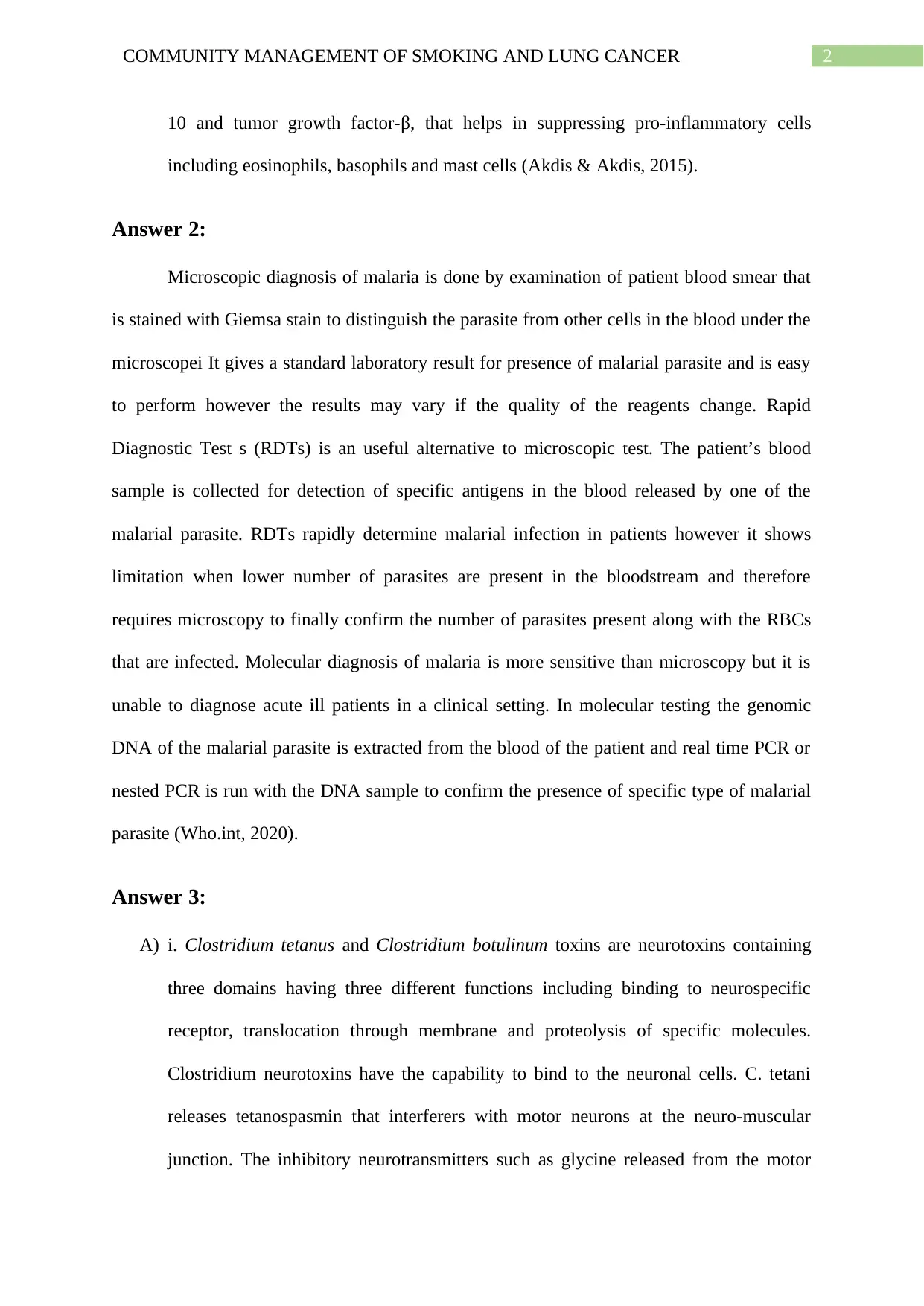
2COMMUNITY MANAGEMENT OF SMOKING AND LUNG CANCER
10 and tumor growth factor-β, that helps in suppressing pro-inflammatory cells
including eosinophils, basophils and mast cells (Akdis & Akdis, 2015).
Answer 2:
Microscopic diagnosis of malaria is done by examination of patient blood smear that
is stained with Giemsa stain to distinguish the parasite from other cells in the blood under the
microscopei It gives a standard laboratory result for presence of malarial parasite and is easy
to perform however the results may vary if the quality of the reagents change. Rapid
Diagnostic Test s (RDTs) is an useful alternative to microscopic test. The patient’s blood
sample is collected for detection of specific antigens in the blood released by one of the
malarial parasite. RDTs rapidly determine malarial infection in patients however it shows
limitation when lower number of parasites are present in the bloodstream and therefore
requires microscopy to finally confirm the number of parasites present along with the RBCs
that are infected. Molecular diagnosis of malaria is more sensitive than microscopy but it is
unable to diagnose acute ill patients in a clinical setting. In molecular testing the genomic
DNA of the malarial parasite is extracted from the blood of the patient and real time PCR or
nested PCR is run with the DNA sample to confirm the presence of specific type of malarial
parasite (Who.int, 2020).
Answer 3:
A) i. Clostridium tetanus and Clostridium botulinum toxins are neurotoxins containing
three domains having three different functions including binding to neurospecific
receptor, translocation through membrane and proteolysis of specific molecules.
Clostridium neurotoxins have the capability to bind to the neuronal cells. C. tetani
releases tetanospasmin that interferers with motor neurons at the neuro-muscular
junction. The inhibitory neurotransmitters such as glycine released from the motor
10 and tumor growth factor-β, that helps in suppressing pro-inflammatory cells
including eosinophils, basophils and mast cells (Akdis & Akdis, 2015).
Answer 2:
Microscopic diagnosis of malaria is done by examination of patient blood smear that
is stained with Giemsa stain to distinguish the parasite from other cells in the blood under the
microscopei It gives a standard laboratory result for presence of malarial parasite and is easy
to perform however the results may vary if the quality of the reagents change. Rapid
Diagnostic Test s (RDTs) is an useful alternative to microscopic test. The patient’s blood
sample is collected for detection of specific antigens in the blood released by one of the
malarial parasite. RDTs rapidly determine malarial infection in patients however it shows
limitation when lower number of parasites are present in the bloodstream and therefore
requires microscopy to finally confirm the number of parasites present along with the RBCs
that are infected. Molecular diagnosis of malaria is more sensitive than microscopy but it is
unable to diagnose acute ill patients in a clinical setting. In molecular testing the genomic
DNA of the malarial parasite is extracted from the blood of the patient and real time PCR or
nested PCR is run with the DNA sample to confirm the presence of specific type of malarial
parasite (Who.int, 2020).
Answer 3:
A) i. Clostridium tetanus and Clostridium botulinum toxins are neurotoxins containing
three domains having three different functions including binding to neurospecific
receptor, translocation through membrane and proteolysis of specific molecules.
Clostridium neurotoxins have the capability to bind to the neuronal cells. C. tetani
releases tetanospasmin that interferers with motor neurons at the neuro-muscular
junction. The inhibitory neurotransmitters such as glycine released from the motor
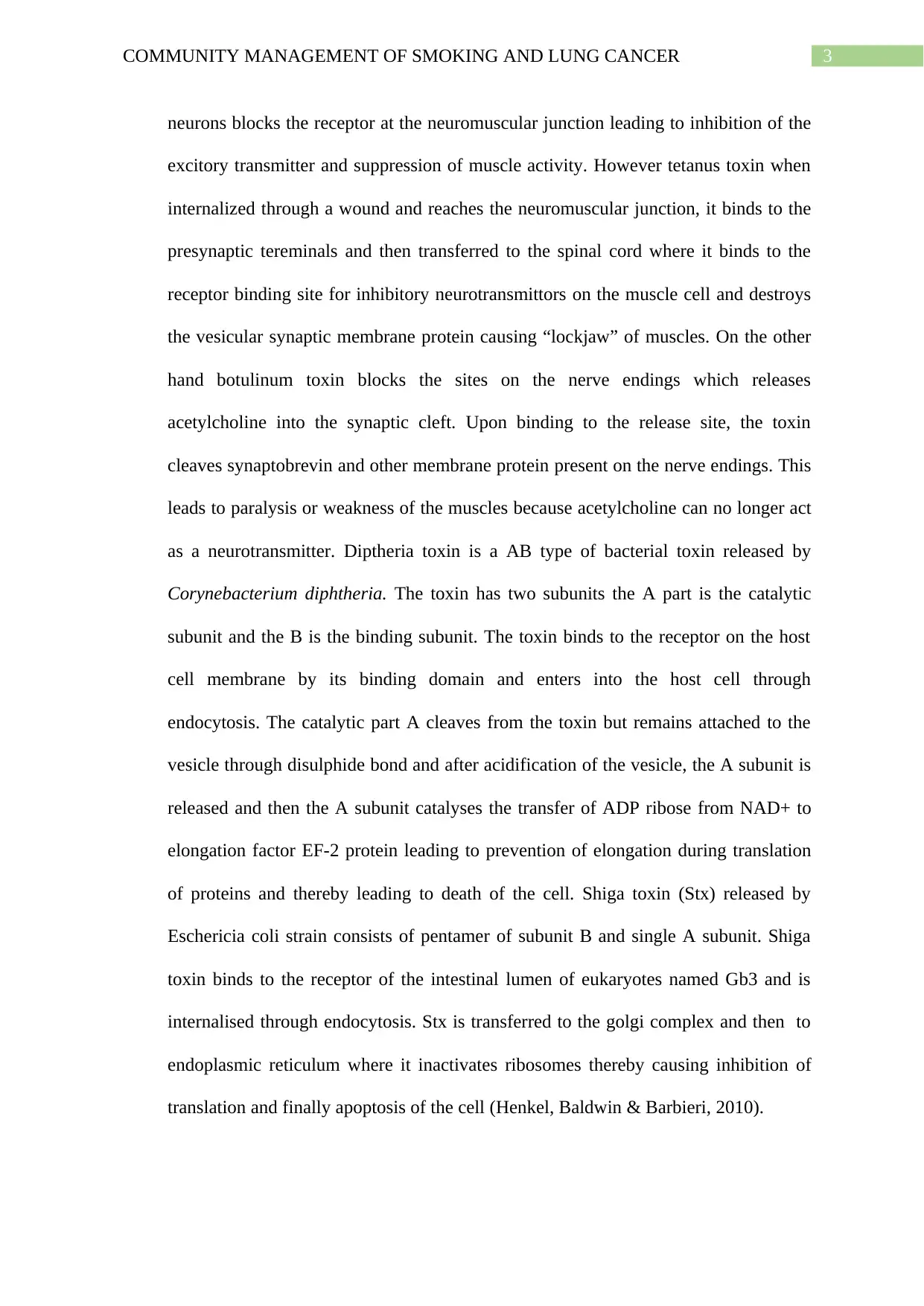
3COMMUNITY MANAGEMENT OF SMOKING AND LUNG CANCER
neurons blocks the receptor at the neuromuscular junction leading to inhibition of the
excitory transmitter and suppression of muscle activity. However tetanus toxin when
internalized through a wound and reaches the neuromuscular junction, it binds to the
presynaptic tereminals and then transferred to the spinal cord where it binds to the
receptor binding site for inhibitory neurotransmittors on the muscle cell and destroys
the vesicular synaptic membrane protein causing “lockjaw” of muscles. On the other
hand botulinum toxin blocks the sites on the nerve endings which releases
acetylcholine into the synaptic cleft. Upon binding to the release site, the toxin
cleaves synaptobrevin and other membrane protein present on the nerve endings. This
leads to paralysis or weakness of the muscles because acetylcholine can no longer act
as a neurotransmitter. Diptheria toxin is a AB type of bacterial toxin released by
Corynebacterium diphtheria. The toxin has two subunits the A part is the catalytic
subunit and the B is the binding subunit. The toxin binds to the receptor on the host
cell membrane by its binding domain and enters into the host cell through
endocytosis. The catalytic part A cleaves from the toxin but remains attached to the
vesicle through disulphide bond and after acidification of the vesicle, the A subunit is
released and then the A subunit catalyses the transfer of ADP ribose from NAD+ to
elongation factor EF-2 protein leading to prevention of elongation during translation
of proteins and thereby leading to death of the cell. Shiga toxin (Stx) released by
Eschericia coli strain consists of pentamer of subunit B and single A subunit. Shiga
toxin binds to the receptor of the intestinal lumen of eukaryotes named Gb3 and is
internalised through endocytosis. Stx is transferred to the golgi complex and then to
endoplasmic reticulum where it inactivates ribosomes thereby causing inhibition of
translation and finally apoptosis of the cell (Henkel, Baldwin & Barbieri, 2010).
neurons blocks the receptor at the neuromuscular junction leading to inhibition of the
excitory transmitter and suppression of muscle activity. However tetanus toxin when
internalized through a wound and reaches the neuromuscular junction, it binds to the
presynaptic tereminals and then transferred to the spinal cord where it binds to the
receptor binding site for inhibitory neurotransmittors on the muscle cell and destroys
the vesicular synaptic membrane protein causing “lockjaw” of muscles. On the other
hand botulinum toxin blocks the sites on the nerve endings which releases
acetylcholine into the synaptic cleft. Upon binding to the release site, the toxin
cleaves synaptobrevin and other membrane protein present on the nerve endings. This
leads to paralysis or weakness of the muscles because acetylcholine can no longer act
as a neurotransmitter. Diptheria toxin is a AB type of bacterial toxin released by
Corynebacterium diphtheria. The toxin has two subunits the A part is the catalytic
subunit and the B is the binding subunit. The toxin binds to the receptor on the host
cell membrane by its binding domain and enters into the host cell through
endocytosis. The catalytic part A cleaves from the toxin but remains attached to the
vesicle through disulphide bond and after acidification of the vesicle, the A subunit is
released and then the A subunit catalyses the transfer of ADP ribose from NAD+ to
elongation factor EF-2 protein leading to prevention of elongation during translation
of proteins and thereby leading to death of the cell. Shiga toxin (Stx) released by
Eschericia coli strain consists of pentamer of subunit B and single A subunit. Shiga
toxin binds to the receptor of the intestinal lumen of eukaryotes named Gb3 and is
internalised through endocytosis. Stx is transferred to the golgi complex and then to
endoplasmic reticulum where it inactivates ribosomes thereby causing inhibition of
translation and finally apoptosis of the cell (Henkel, Baldwin & Barbieri, 2010).
Secure Best Marks with AI Grader
Need help grading? Try our AI Grader for instant feedback on your assignments.
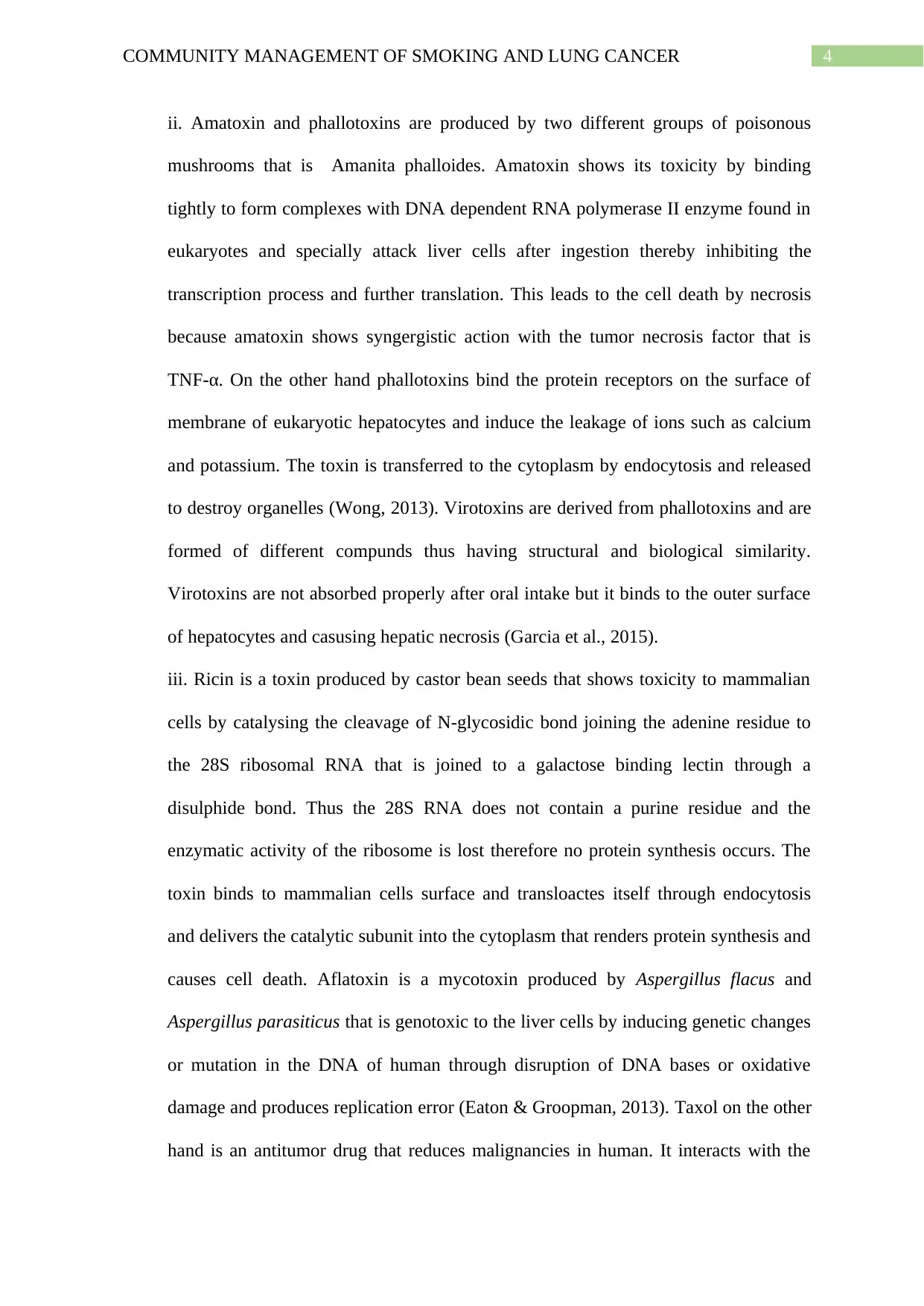
4COMMUNITY MANAGEMENT OF SMOKING AND LUNG CANCER
ii. Amatoxin and phallotoxins are produced by two different groups of poisonous
mushrooms that is Amanita phalloides. Amatoxin shows its toxicity by binding
tightly to form complexes with DNA dependent RNA polymerase II enzyme found in
eukaryotes and specially attack liver cells after ingestion thereby inhibiting the
transcription process and further translation. This leads to the cell death by necrosis
because amatoxin shows syngergistic action with the tumor necrosis factor that is
TNF-α. On the other hand phallotoxins bind the protein receptors on the surface of
membrane of eukaryotic hepatocytes and induce the leakage of ions such as calcium
and potassium. The toxin is transferred to the cytoplasm by endocytosis and released
to destroy organelles (Wong, 2013). Virotoxins are derived from phallotoxins and are
formed of different compunds thus having structural and biological similarity.
Virotoxins are not absorbed properly after oral intake but it binds to the outer surface
of hepatocytes and casusing hepatic necrosis (Garcia et al., 2015).
iii. Ricin is a toxin produced by castor bean seeds that shows toxicity to mammalian
cells by catalysing the cleavage of N-glycosidic bond joining the adenine residue to
the 28S ribosomal RNA that is joined to a galactose binding lectin through a
disulphide bond. Thus the 28S RNA does not contain a purine residue and the
enzymatic activity of the ribosome is lost therefore no protein synthesis occurs. The
toxin binds to mammalian cells surface and transloactes itself through endocytosis
and delivers the catalytic subunit into the cytoplasm that renders protein synthesis and
causes cell death. Aflatoxin is a mycotoxin produced by Aspergillus flacus and
Aspergillus parasiticus that is genotoxic to the liver cells by inducing genetic changes
or mutation in the DNA of human through disruption of DNA bases or oxidative
damage and produces replication error (Eaton & Groopman, 2013). Taxol on the other
hand is an antitumor drug that reduces malignancies in human. It interacts with the
ii. Amatoxin and phallotoxins are produced by two different groups of poisonous
mushrooms that is Amanita phalloides. Amatoxin shows its toxicity by binding
tightly to form complexes with DNA dependent RNA polymerase II enzyme found in
eukaryotes and specially attack liver cells after ingestion thereby inhibiting the
transcription process and further translation. This leads to the cell death by necrosis
because amatoxin shows syngergistic action with the tumor necrosis factor that is
TNF-α. On the other hand phallotoxins bind the protein receptors on the surface of
membrane of eukaryotic hepatocytes and induce the leakage of ions such as calcium
and potassium. The toxin is transferred to the cytoplasm by endocytosis and released
to destroy organelles (Wong, 2013). Virotoxins are derived from phallotoxins and are
formed of different compunds thus having structural and biological similarity.
Virotoxins are not absorbed properly after oral intake but it binds to the outer surface
of hepatocytes and casusing hepatic necrosis (Garcia et al., 2015).
iii. Ricin is a toxin produced by castor bean seeds that shows toxicity to mammalian
cells by catalysing the cleavage of N-glycosidic bond joining the adenine residue to
the 28S ribosomal RNA that is joined to a galactose binding lectin through a
disulphide bond. Thus the 28S RNA does not contain a purine residue and the
enzymatic activity of the ribosome is lost therefore no protein synthesis occurs. The
toxin binds to mammalian cells surface and transloactes itself through endocytosis
and delivers the catalytic subunit into the cytoplasm that renders protein synthesis and
causes cell death. Aflatoxin is a mycotoxin produced by Aspergillus flacus and
Aspergillus parasiticus that is genotoxic to the liver cells by inducing genetic changes
or mutation in the DNA of human through disruption of DNA bases or oxidative
damage and produces replication error (Eaton & Groopman, 2013). Taxol on the other
hand is an antitumor drug that reduces malignancies in human. It interacts with the
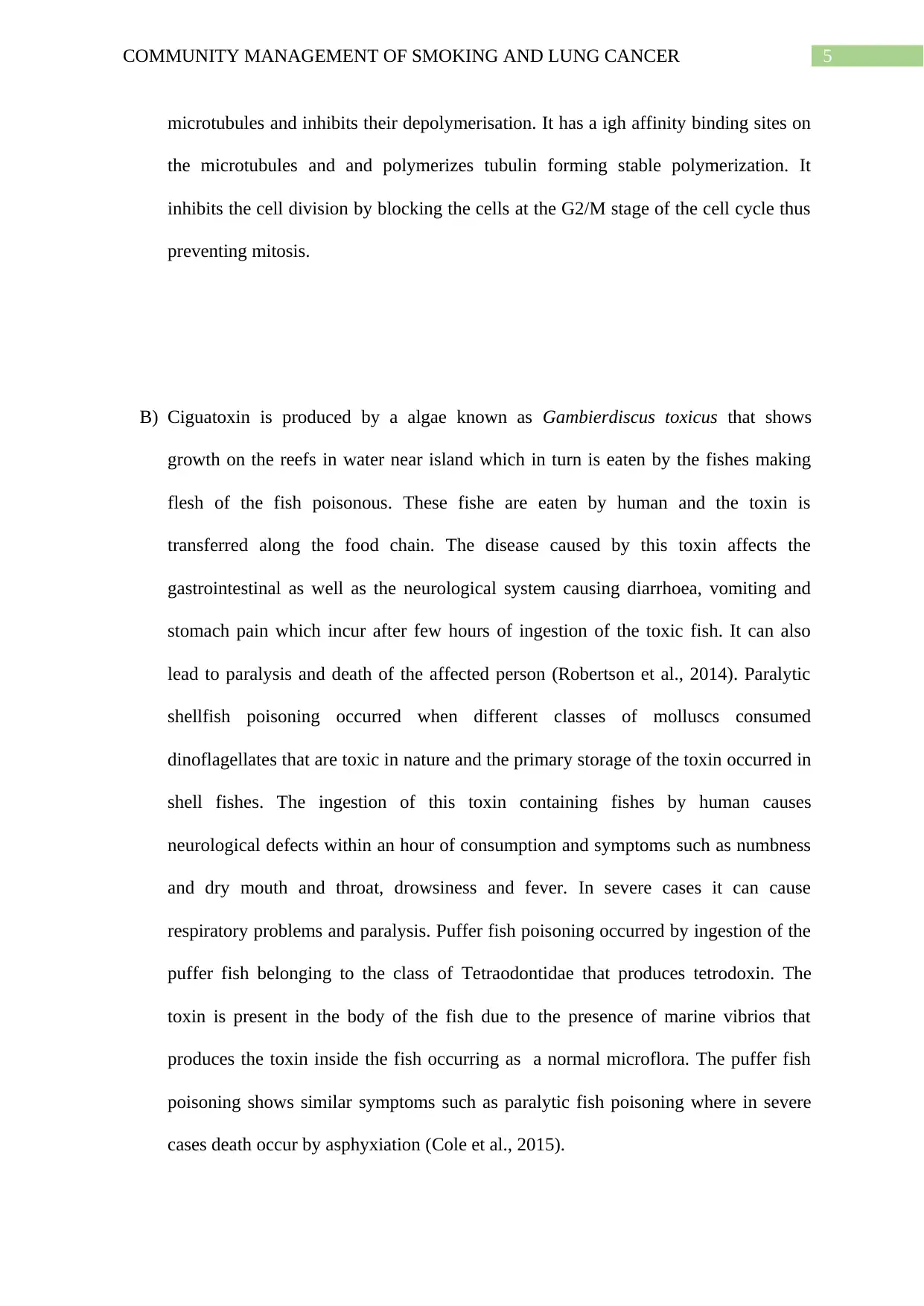
5COMMUNITY MANAGEMENT OF SMOKING AND LUNG CANCER
microtubules and inhibits their depolymerisation. It has a igh affinity binding sites on
the microtubules and and polymerizes tubulin forming stable polymerization. It
inhibits the cell division by blocking the cells at the G2/M stage of the cell cycle thus
preventing mitosis.
B) Ciguatoxin is produced by a algae known as Gambierdiscus toxicus that shows
growth on the reefs in water near island which in turn is eaten by the fishes making
flesh of the fish poisonous. These fishe are eaten by human and the toxin is
transferred along the food chain. The disease caused by this toxin affects the
gastrointestinal as well as the neurological system causing diarrhoea, vomiting and
stomach pain which incur after few hours of ingestion of the toxic fish. It can also
lead to paralysis and death of the affected person (Robertson et al., 2014). Paralytic
shellfish poisoning occurred when different classes of molluscs consumed
dinoflagellates that are toxic in nature and the primary storage of the toxin occurred in
shell fishes. The ingestion of this toxin containing fishes by human causes
neurological defects within an hour of consumption and symptoms such as numbness
and dry mouth and throat, drowsiness and fever. In severe cases it can cause
respiratory problems and paralysis. Puffer fish poisoning occurred by ingestion of the
puffer fish belonging to the class of Tetraodontidae that produces tetrodoxin. The
toxin is present in the body of the fish due to the presence of marine vibrios that
produces the toxin inside the fish occurring as a normal microflora. The puffer fish
poisoning shows similar symptoms such as paralytic fish poisoning where in severe
cases death occur by asphyxiation (Cole et al., 2015).
microtubules and inhibits their depolymerisation. It has a igh affinity binding sites on
the microtubules and and polymerizes tubulin forming stable polymerization. It
inhibits the cell division by blocking the cells at the G2/M stage of the cell cycle thus
preventing mitosis.
B) Ciguatoxin is produced by a algae known as Gambierdiscus toxicus that shows
growth on the reefs in water near island which in turn is eaten by the fishes making
flesh of the fish poisonous. These fishe are eaten by human and the toxin is
transferred along the food chain. The disease caused by this toxin affects the
gastrointestinal as well as the neurological system causing diarrhoea, vomiting and
stomach pain which incur after few hours of ingestion of the toxic fish. It can also
lead to paralysis and death of the affected person (Robertson et al., 2014). Paralytic
shellfish poisoning occurred when different classes of molluscs consumed
dinoflagellates that are toxic in nature and the primary storage of the toxin occurred in
shell fishes. The ingestion of this toxin containing fishes by human causes
neurological defects within an hour of consumption and symptoms such as numbness
and dry mouth and throat, drowsiness and fever. In severe cases it can cause
respiratory problems and paralysis. Puffer fish poisoning occurred by ingestion of the
puffer fish belonging to the class of Tetraodontidae that produces tetrodoxin. The
toxin is present in the body of the fish due to the presence of marine vibrios that
produces the toxin inside the fish occurring as a normal microflora. The puffer fish
poisoning shows similar symptoms such as paralytic fish poisoning where in severe
cases death occur by asphyxiation (Cole et al., 2015).

6COMMUNITY MANAGEMENT OF SMOKING AND LUNG CANCER
C)
Toxic material Origin/found Toxic effect
Sudan red Dyes in industry, stain
and food colour enhancer
in chilli powder and other
fod products.
Causes cancer by
damaging DNA.toxic to
animals and human (Teng
& Zhou, 2017).
Malachite green Mined from deposits at e
Isthmus of Suez and the
Sinai as basic copper
carbonate. At present
chemically made (Susarla
et al., 2017).
It kills fungal and parasitic
infection in aquaculture
and food but shows
toxicity to animals causing
carcinogenesis and
multiple organ failure due
to DNA damage.
melamine Chemically synthesized
found in thermosetting
plastic and laminates and
also as a food adulterant
Causes kidney damage or
nephrotoxicity when
combined with uric acid
(Rai et al., 2014).
phthalate (plasticizer) Used as plasticizer in
plastics in the PVC
industry.
Reproductive toxicity in
male making them sterile
and in pregnant women
through cellular damage
(Rowdhwal & Chen,
C)
Toxic material Origin/found Toxic effect
Sudan red Dyes in industry, stain
and food colour enhancer
in chilli powder and other
fod products.
Causes cancer by
damaging DNA.toxic to
animals and human (Teng
& Zhou, 2017).
Malachite green Mined from deposits at e
Isthmus of Suez and the
Sinai as basic copper
carbonate. At present
chemically made (Susarla
et al., 2017).
It kills fungal and parasitic
infection in aquaculture
and food but shows
toxicity to animals causing
carcinogenesis and
multiple organ failure due
to DNA damage.
melamine Chemically synthesized
found in thermosetting
plastic and laminates and
also as a food adulterant
Causes kidney damage or
nephrotoxicity when
combined with uric acid
(Rai et al., 2014).
phthalate (plasticizer) Used as plasticizer in
plastics in the PVC
industry.
Reproductive toxicity in
male making them sterile
and in pregnant women
through cellular damage
(Rowdhwal & Chen,
Paraphrase This Document
Need a fresh take? Get an instant paraphrase of this document with our AI Paraphraser

7COMMUNITY MANAGEMENT OF SMOKING AND LUNG CANCER
2018).
heroin It is morphine alkaloid
found in opium poppy
seed pod.
Inhalation or injection as
drugs shows toxicity on
the central nervous system
and overdose can lead to
death (Darke, 2016).
cocaine First extracted from coca
leaves
Effects on the whole body
and leads to vascular
dysfunction because of its
vasoconstrictive function
and also changes the
psychological behaviour
(Biondich & Joslin, 2016).
D)
Drugs Therapeutic actions
Diazepam It acts as a sedative, relaxes muscle,
amnesic property and manages anxiety
and withdrawal syndrome (Drugbank.ca,
2020).
phenobarbital Sedation and hypnotising action.
Manages seizure and relieves insomnia
(Lewis & Adams, 2019).
Amphetamine Reduce anesthesia effect and induces
arousal and sleep deprival, euphoria
2018).
heroin It is morphine alkaloid
found in opium poppy
seed pod.
Inhalation or injection as
drugs shows toxicity on
the central nervous system
and overdose can lead to
death (Darke, 2016).
cocaine First extracted from coca
leaves
Effects on the whole body
and leads to vascular
dysfunction because of its
vasoconstrictive function
and also changes the
psychological behaviour
(Biondich & Joslin, 2016).
D)
Drugs Therapeutic actions
Diazepam It acts as a sedative, relaxes muscle,
amnesic property and manages anxiety
and withdrawal syndrome (Drugbank.ca,
2020).
phenobarbital Sedation and hypnotising action.
Manages seizure and relieves insomnia
(Lewis & Adams, 2019).
Amphetamine Reduce anesthesia effect and induces
arousal and sleep deprival, euphoria
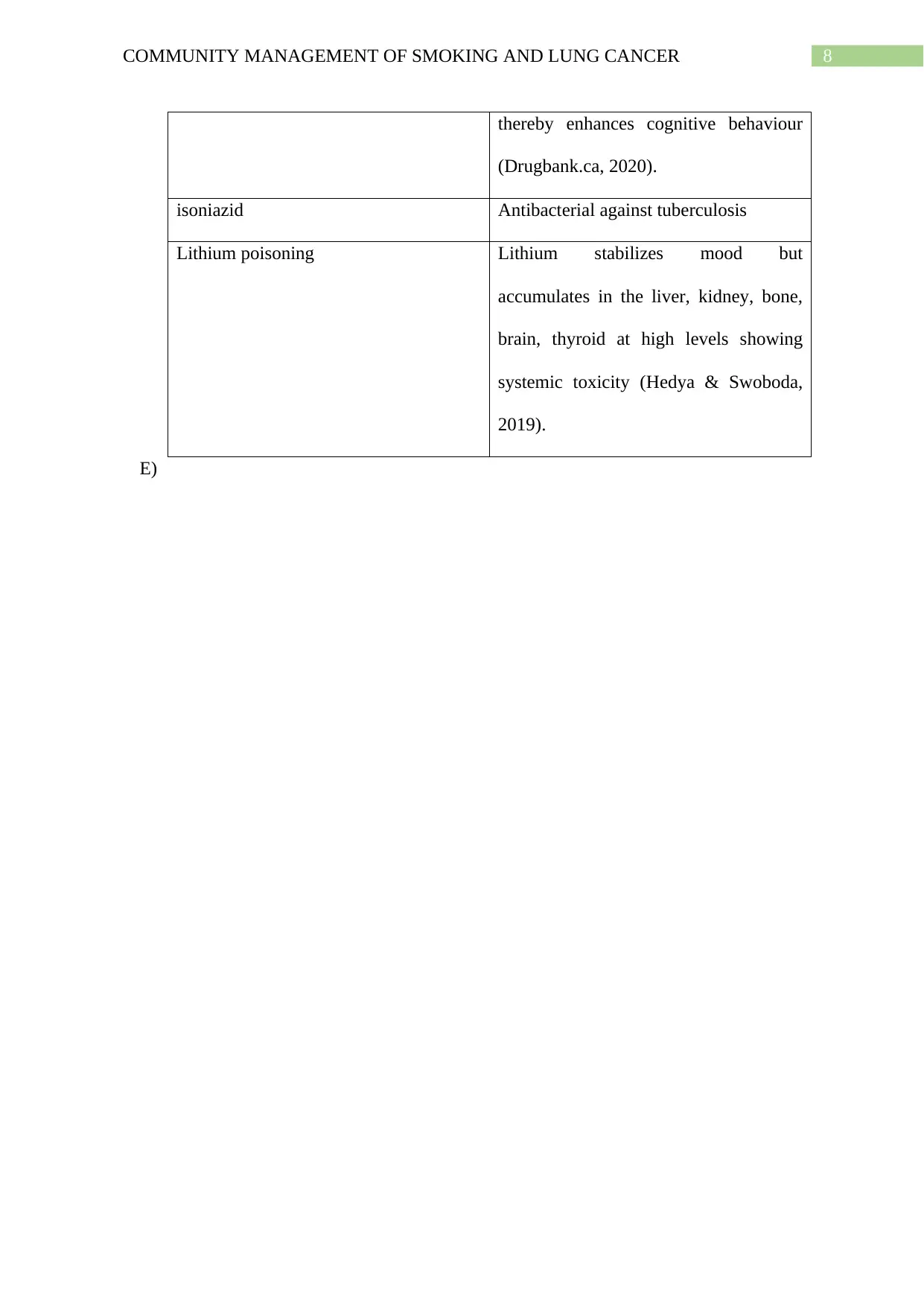
8COMMUNITY MANAGEMENT OF SMOKING AND LUNG CANCER
thereby enhances cognitive behaviour
(Drugbank.ca, 2020).
isoniazid Antibacterial against tuberculosis
Lithium poisoning Lithium stabilizes mood but
accumulates in the liver, kidney, bone,
brain, thyroid at high levels showing
systemic toxicity (Hedya & Swoboda,
2019).
E)
thereby enhances cognitive behaviour
(Drugbank.ca, 2020).
isoniazid Antibacterial against tuberculosis
Lithium poisoning Lithium stabilizes mood but
accumulates in the liver, kidney, bone,
brain, thyroid at high levels showing
systemic toxicity (Hedya & Swoboda,
2019).
E)
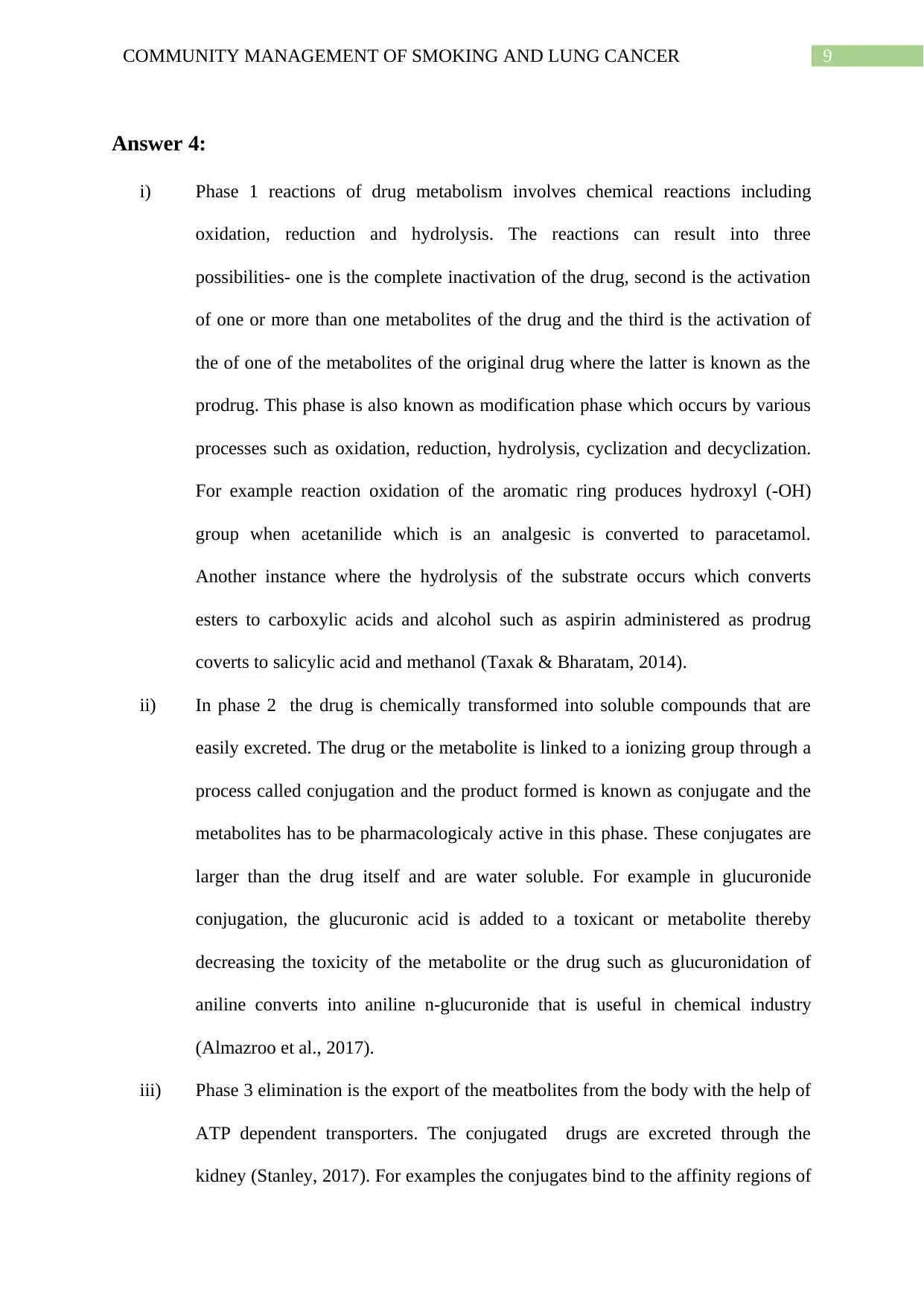
9COMMUNITY MANAGEMENT OF SMOKING AND LUNG CANCER
Answer 4:
i) Phase 1 reactions of drug metabolism involves chemical reactions including
oxidation, reduction and hydrolysis. The reactions can result into three
possibilities- one is the complete inactivation of the drug, second is the activation
of one or more than one metabolites of the drug and the third is the activation of
the of one of the metabolites of the original drug where the latter is known as the
prodrug. This phase is also known as modification phase which occurs by various
processes such as oxidation, reduction, hydrolysis, cyclization and decyclization.
For example reaction oxidation of the aromatic ring produces hydroxyl (-OH)
group when acetanilide which is an analgesic is converted to paracetamol.
Another instance where the hydrolysis of the substrate occurs which converts
esters to carboxylic acids and alcohol such as aspirin administered as prodrug
coverts to salicylic acid and methanol (Taxak & Bharatam, 2014).
ii) In phase 2 the drug is chemically transformed into soluble compounds that are
easily excreted. The drug or the metabolite is linked to a ionizing group through a
process called conjugation and the product formed is known as conjugate and the
metabolites has to be pharmacologicaly active in this phase. These conjugates are
larger than the drug itself and are water soluble. For example in glucuronide
conjugation, the glucuronic acid is added to a toxicant or metabolite thereby
decreasing the toxicity of the metabolite or the drug such as glucuronidation of
aniline converts into aniline n-glucuronide that is useful in chemical industry
(Almazroo et al., 2017).
iii) Phase 3 elimination is the export of the meatbolites from the body with the help of
ATP dependent transporters. The conjugated drugs are excreted through the
kidney (Stanley, 2017). For examples the conjugates bind to the affinity regions of
Answer 4:
i) Phase 1 reactions of drug metabolism involves chemical reactions including
oxidation, reduction and hydrolysis. The reactions can result into three
possibilities- one is the complete inactivation of the drug, second is the activation
of one or more than one metabolites of the drug and the third is the activation of
the of one of the metabolites of the original drug where the latter is known as the
prodrug. This phase is also known as modification phase which occurs by various
processes such as oxidation, reduction, hydrolysis, cyclization and decyclization.
For example reaction oxidation of the aromatic ring produces hydroxyl (-OH)
group when acetanilide which is an analgesic is converted to paracetamol.
Another instance where the hydrolysis of the substrate occurs which converts
esters to carboxylic acids and alcohol such as aspirin administered as prodrug
coverts to salicylic acid and methanol (Taxak & Bharatam, 2014).
ii) In phase 2 the drug is chemically transformed into soluble compounds that are
easily excreted. The drug or the metabolite is linked to a ionizing group through a
process called conjugation and the product formed is known as conjugate and the
metabolites has to be pharmacologicaly active in this phase. These conjugates are
larger than the drug itself and are water soluble. For example in glucuronide
conjugation, the glucuronic acid is added to a toxicant or metabolite thereby
decreasing the toxicity of the metabolite or the drug such as glucuronidation of
aniline converts into aniline n-glucuronide that is useful in chemical industry
(Almazroo et al., 2017).
iii) Phase 3 elimination is the export of the meatbolites from the body with the help of
ATP dependent transporters. The conjugated drugs are excreted through the
kidney (Stanley, 2017). For examples the conjugates bind to the affinity regions of
Secure Best Marks with AI Grader
Need help grading? Try our AI Grader for instant feedback on your assignments.
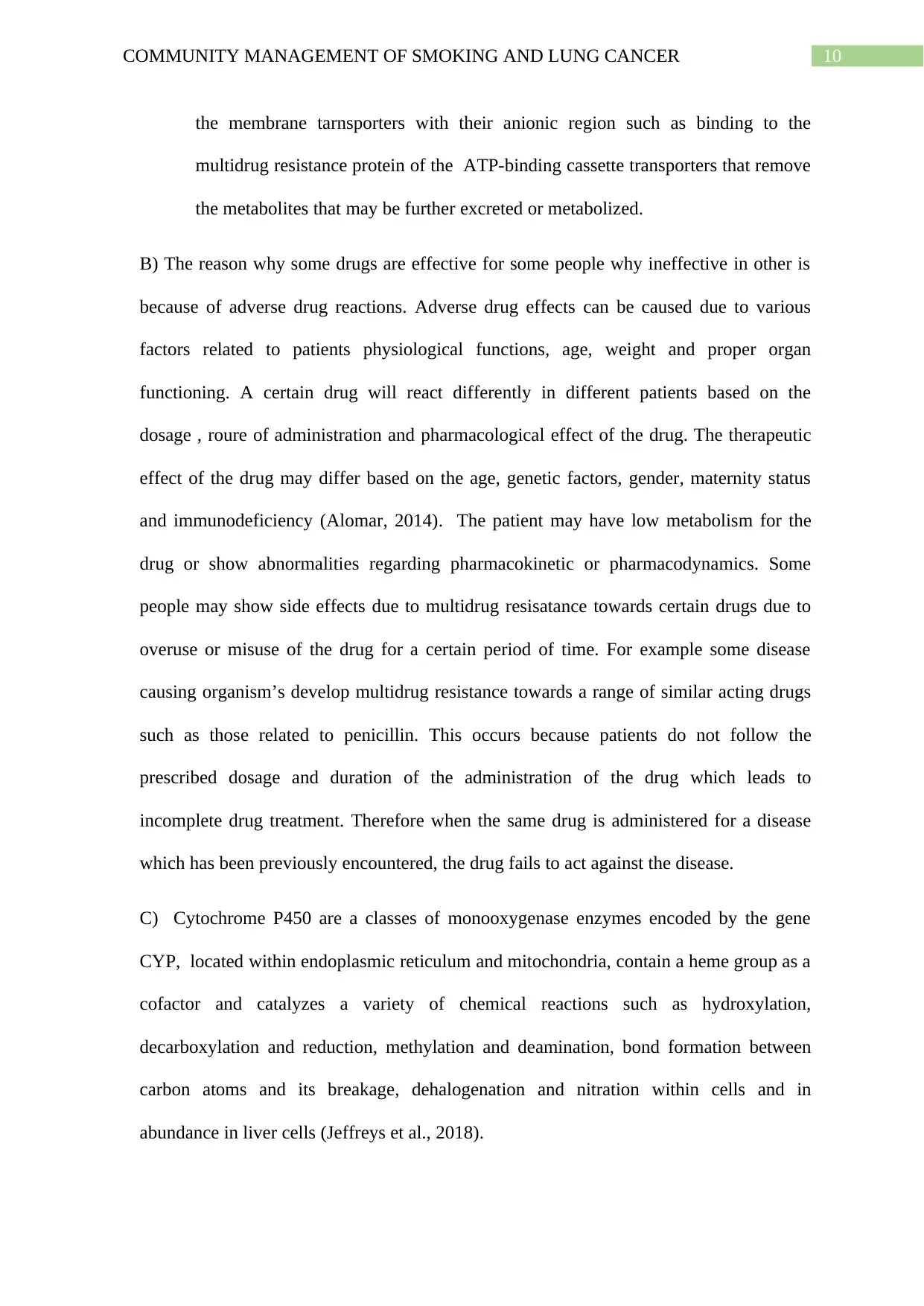
10COMMUNITY MANAGEMENT OF SMOKING AND LUNG CANCER
the membrane tarnsporters with their anionic region such as binding to the
multidrug resistance protein of the ATP-binding cassette transporters that remove
the metabolites that may be further excreted or metabolized.
B) The reason why some drugs are effective for some people why ineffective in other is
because of adverse drug reactions. Adverse drug effects can be caused due to various
factors related to patients physiological functions, age, weight and proper organ
functioning. A certain drug will react differently in different patients based on the
dosage , roure of administration and pharmacological effect of the drug. The therapeutic
effect of the drug may differ based on the age, genetic factors, gender, maternity status
and immunodeficiency (Alomar, 2014). The patient may have low metabolism for the
drug or show abnormalities regarding pharmacokinetic or pharmacodynamics. Some
people may show side effects due to multidrug resisatance towards certain drugs due to
overuse or misuse of the drug for a certain period of time. For example some disease
causing organism’s develop multidrug resistance towards a range of similar acting drugs
such as those related to penicillin. This occurs because patients do not follow the
prescribed dosage and duration of the administration of the drug which leads to
incomplete drug treatment. Therefore when the same drug is administered for a disease
which has been previously encountered, the drug fails to act against the disease.
C) Cytochrome P450 are a classes of monooxygenase enzymes encoded by the gene
CYP, located within endoplasmic reticulum and mitochondria, contain a heme group as a
cofactor and catalyzes a variety of chemical reactions such as hydroxylation,
decarboxylation and reduction, methylation and deamination, bond formation between
carbon atoms and its breakage, dehalogenation and nitration within cells and in
abundance in liver cells (Jeffreys et al., 2018).
the membrane tarnsporters with their anionic region such as binding to the
multidrug resistance protein of the ATP-binding cassette transporters that remove
the metabolites that may be further excreted or metabolized.
B) The reason why some drugs are effective for some people why ineffective in other is
because of adverse drug reactions. Adverse drug effects can be caused due to various
factors related to patients physiological functions, age, weight and proper organ
functioning. A certain drug will react differently in different patients based on the
dosage , roure of administration and pharmacological effect of the drug. The therapeutic
effect of the drug may differ based on the age, genetic factors, gender, maternity status
and immunodeficiency (Alomar, 2014). The patient may have low metabolism for the
drug or show abnormalities regarding pharmacokinetic or pharmacodynamics. Some
people may show side effects due to multidrug resisatance towards certain drugs due to
overuse or misuse of the drug for a certain period of time. For example some disease
causing organism’s develop multidrug resistance towards a range of similar acting drugs
such as those related to penicillin. This occurs because patients do not follow the
prescribed dosage and duration of the administration of the drug which leads to
incomplete drug treatment. Therefore when the same drug is administered for a disease
which has been previously encountered, the drug fails to act against the disease.
C) Cytochrome P450 are a classes of monooxygenase enzymes encoded by the gene
CYP, located within endoplasmic reticulum and mitochondria, contain a heme group as a
cofactor and catalyzes a variety of chemical reactions such as hydroxylation,
decarboxylation and reduction, methylation and deamination, bond formation between
carbon atoms and its breakage, dehalogenation and nitration within cells and in
abundance in liver cells (Jeffreys et al., 2018).
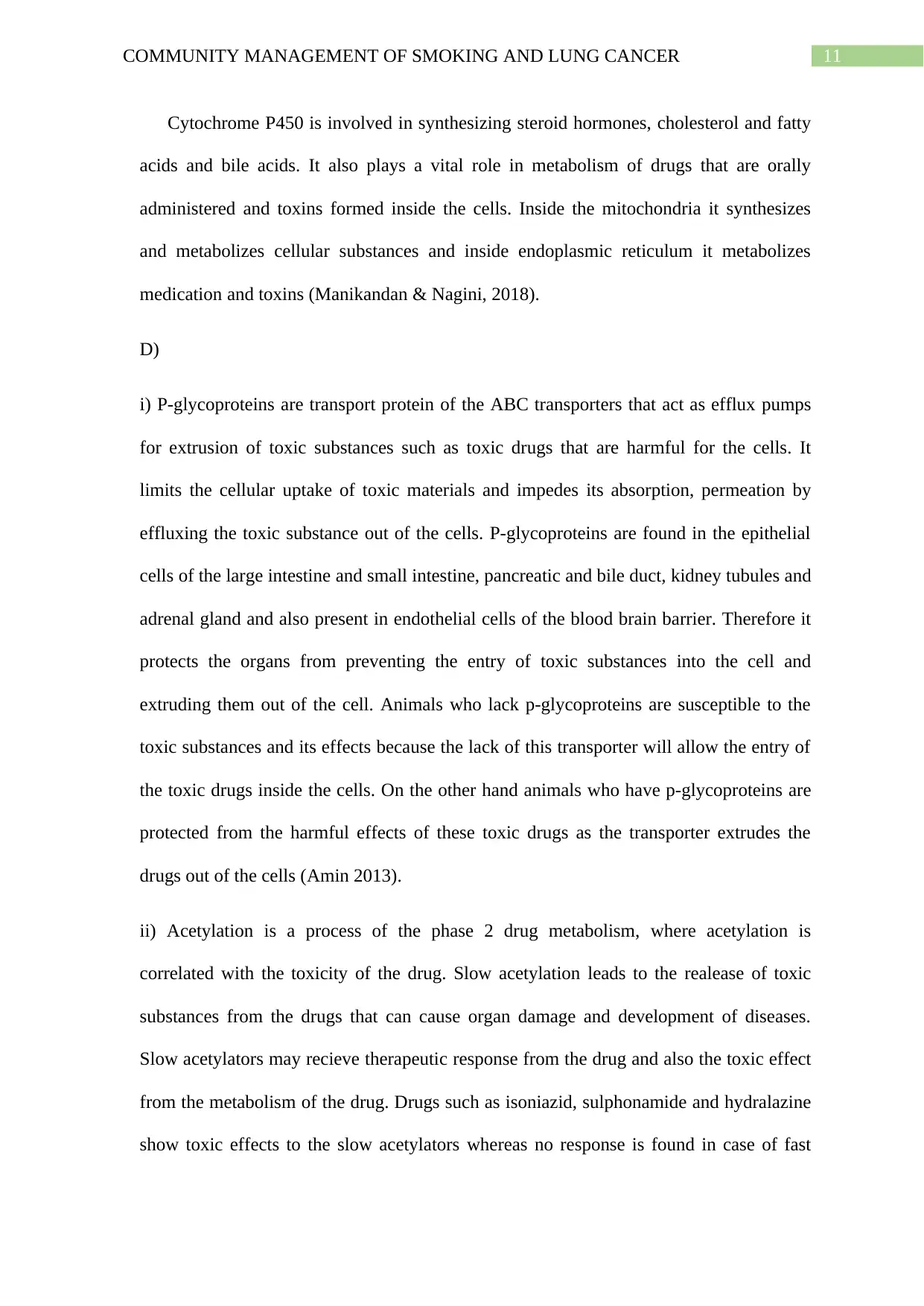
11COMMUNITY MANAGEMENT OF SMOKING AND LUNG CANCER
Cytochrome P450 is involved in synthesizing steroid hormones, cholesterol and fatty
acids and bile acids. It also plays a vital role in metabolism of drugs that are orally
administered and toxins formed inside the cells. Inside the mitochondria it synthesizes
and metabolizes cellular substances and inside endoplasmic reticulum it metabolizes
medication and toxins (Manikandan & Nagini, 2018).
D)
i) P-glycoproteins are transport protein of the ABC transporters that act as efflux pumps
for extrusion of toxic substances such as toxic drugs that are harmful for the cells. It
limits the cellular uptake of toxic materials and impedes its absorption, permeation by
effluxing the toxic substance out of the cells. P-glycoproteins are found in the epithelial
cells of the large intestine and small intestine, pancreatic and bile duct, kidney tubules and
adrenal gland and also present in endothelial cells of the blood brain barrier. Therefore it
protects the organs from preventing the entry of toxic substances into the cell and
extruding them out of the cell. Animals who lack p-glycoproteins are susceptible to the
toxic substances and its effects because the lack of this transporter will allow the entry of
the toxic drugs inside the cells. On the other hand animals who have p-glycoproteins are
protected from the harmful effects of these toxic drugs as the transporter extrudes the
drugs out of the cells (Amin 2013).
ii) Acetylation is a process of the phase 2 drug metabolism, where acetylation is
correlated with the toxicity of the drug. Slow acetylation leads to the realease of toxic
substances from the drugs that can cause organ damage and development of diseases.
Slow acetylators may recieve therapeutic response from the drug and also the toxic effect
from the metabolism of the drug. Drugs such as isoniazid, sulphonamide and hydralazine
show toxic effects to the slow acetylators whereas no response is found in case of fast
Cytochrome P450 is involved in synthesizing steroid hormones, cholesterol and fatty
acids and bile acids. It also plays a vital role in metabolism of drugs that are orally
administered and toxins formed inside the cells. Inside the mitochondria it synthesizes
and metabolizes cellular substances and inside endoplasmic reticulum it metabolizes
medication and toxins (Manikandan & Nagini, 2018).
D)
i) P-glycoproteins are transport protein of the ABC transporters that act as efflux pumps
for extrusion of toxic substances such as toxic drugs that are harmful for the cells. It
limits the cellular uptake of toxic materials and impedes its absorption, permeation by
effluxing the toxic substance out of the cells. P-glycoproteins are found in the epithelial
cells of the large intestine and small intestine, pancreatic and bile duct, kidney tubules and
adrenal gland and also present in endothelial cells of the blood brain barrier. Therefore it
protects the organs from preventing the entry of toxic substances into the cell and
extruding them out of the cell. Animals who lack p-glycoproteins are susceptible to the
toxic substances and its effects because the lack of this transporter will allow the entry of
the toxic drugs inside the cells. On the other hand animals who have p-glycoproteins are
protected from the harmful effects of these toxic drugs as the transporter extrudes the
drugs out of the cells (Amin 2013).
ii) Acetylation is a process of the phase 2 drug metabolism, where acetylation is
correlated with the toxicity of the drug. Slow acetylation leads to the realease of toxic
substances from the drugs that can cause organ damage and development of diseases.
Slow acetylators may recieve therapeutic response from the drug and also the toxic effect
from the metabolism of the drug. Drugs such as isoniazid, sulphonamide and hydralazine
show toxic effects to the slow acetylators whereas no response is found in case of fast
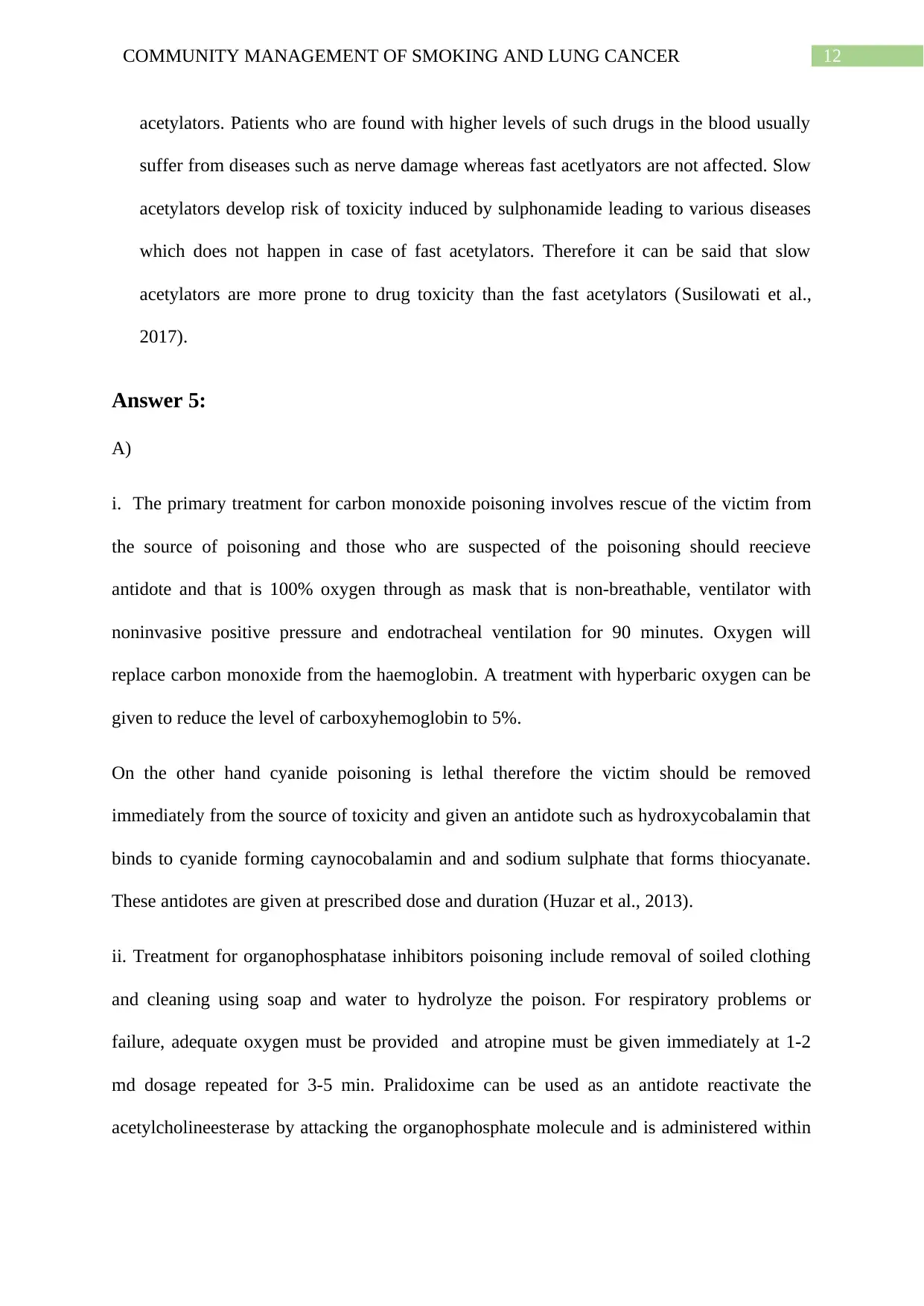
12COMMUNITY MANAGEMENT OF SMOKING AND LUNG CANCER
acetylators. Patients who are found with higher levels of such drugs in the blood usually
suffer from diseases such as nerve damage whereas fast acetlyators are not affected. Slow
acetylators develop risk of toxicity induced by sulphonamide leading to various diseases
which does not happen in case of fast acetylators. Therefore it can be said that slow
acetylators are more prone to drug toxicity than the fast acetylators (Susilowati et al.,
2017).
Answer 5:
A)
i. The primary treatment for carbon monoxide poisoning involves rescue of the victim from
the source of poisoning and those who are suspected of the poisoning should reecieve
antidote and that is 100% oxygen through as mask that is non-breathable, ventilator with
noninvasive positive pressure and endotracheal ventilation for 90 minutes. Oxygen will
replace carbon monoxide from the haemoglobin. A treatment with hyperbaric oxygen can be
given to reduce the level of carboxyhemoglobin to 5%.
On the other hand cyanide poisoning is lethal therefore the victim should be removed
immediately from the source of toxicity and given an antidote such as hydroxycobalamin that
binds to cyanide forming caynocobalamin and and sodium sulphate that forms thiocyanate.
These antidotes are given at prescribed dose and duration (Huzar et al., 2013).
ii. Treatment for organophosphatase inhibitors poisoning include removal of soiled clothing
and cleaning using soap and water to hydrolyze the poison. For respiratory problems or
failure, adequate oxygen must be provided and atropine must be given immediately at 1-2
md dosage repeated for 3-5 min. Pralidoxime can be used as an antidote reactivate the
acetylcholineesterase by attacking the organophosphate molecule and is administered within
acetylators. Patients who are found with higher levels of such drugs in the blood usually
suffer from diseases such as nerve damage whereas fast acetlyators are not affected. Slow
acetylators develop risk of toxicity induced by sulphonamide leading to various diseases
which does not happen in case of fast acetylators. Therefore it can be said that slow
acetylators are more prone to drug toxicity than the fast acetylators (Susilowati et al.,
2017).
Answer 5:
A)
i. The primary treatment for carbon monoxide poisoning involves rescue of the victim from
the source of poisoning and those who are suspected of the poisoning should reecieve
antidote and that is 100% oxygen through as mask that is non-breathable, ventilator with
noninvasive positive pressure and endotracheal ventilation for 90 minutes. Oxygen will
replace carbon monoxide from the haemoglobin. A treatment with hyperbaric oxygen can be
given to reduce the level of carboxyhemoglobin to 5%.
On the other hand cyanide poisoning is lethal therefore the victim should be removed
immediately from the source of toxicity and given an antidote such as hydroxycobalamin that
binds to cyanide forming caynocobalamin and and sodium sulphate that forms thiocyanate.
These antidotes are given at prescribed dose and duration (Huzar et al., 2013).
ii. Treatment for organophosphatase inhibitors poisoning include removal of soiled clothing
and cleaning using soap and water to hydrolyze the poison. For respiratory problems or
failure, adequate oxygen must be provided and atropine must be given immediately at 1-2
md dosage repeated for 3-5 min. Pralidoxime can be used as an antidote reactivate the
acetylcholineesterase by attacking the organophosphate molecule and is administered within
Paraphrase This Document
Need a fresh take? Get an instant paraphrase of this document with our AI Paraphraser
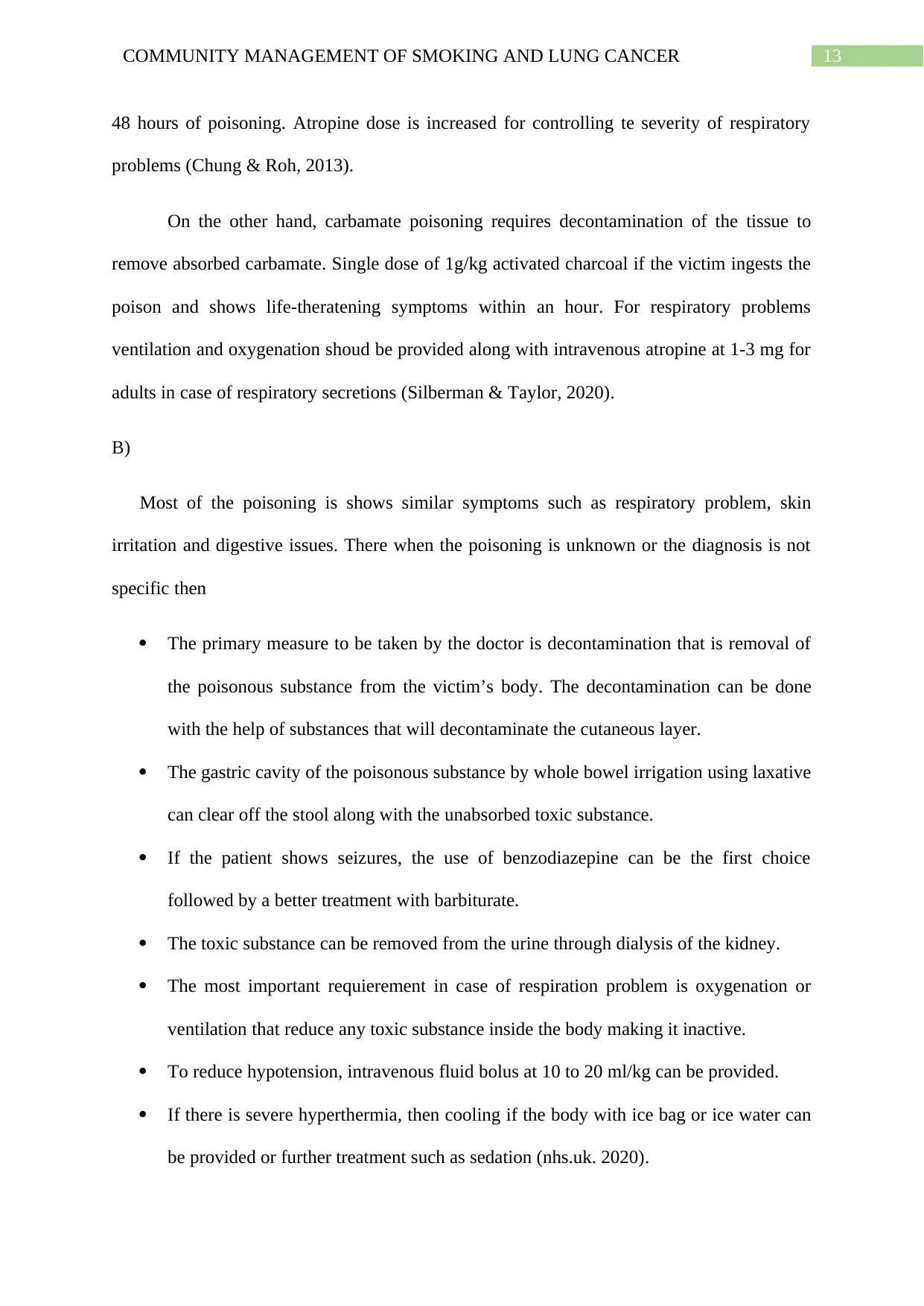
13COMMUNITY MANAGEMENT OF SMOKING AND LUNG CANCER
48 hours of poisoning. Atropine dose is increased for controlling te severity of respiratory
problems (Chung & Roh, 2013).
On the other hand, carbamate poisoning requires decontamination of the tissue to
remove absorbed carbamate. Single dose of 1g/kg activated charcoal if the victim ingests the
poison and shows life-theratening symptoms within an hour. For respiratory problems
ventilation and oxygenation shoud be provided along with intravenous atropine at 1-3 mg for
adults in case of respiratory secretions (Silberman & Taylor, 2020).
B)
Most of the poisoning is shows similar symptoms such as respiratory problem, skin
irritation and digestive issues. There when the poisoning is unknown or the diagnosis is not
specific then
The primary measure to be taken by the doctor is decontamination that is removal of
the poisonous substance from the victim’s body. The decontamination can be done
with the help of substances that will decontaminate the cutaneous layer.
The gastric cavity of the poisonous substance by whole bowel irrigation using laxative
can clear off the stool along with the unabsorbed toxic substance.
If the patient shows seizures, the use of benzodiazepine can be the first choice
followed by a better treatment with barbiturate.
The toxic substance can be removed from the urine through dialysis of the kidney.
The most important requierement in case of respiration problem is oxygenation or
ventilation that reduce any toxic substance inside the body making it inactive.
To reduce hypotension, intravenous fluid bolus at 10 to 20 ml/kg can be provided.
If there is severe hyperthermia, then cooling if the body with ice bag or ice water can
be provided or further treatment such as sedation (nhs.uk. 2020).
48 hours of poisoning. Atropine dose is increased for controlling te severity of respiratory
problems (Chung & Roh, 2013).
On the other hand, carbamate poisoning requires decontamination of the tissue to
remove absorbed carbamate. Single dose of 1g/kg activated charcoal if the victim ingests the
poison and shows life-theratening symptoms within an hour. For respiratory problems
ventilation and oxygenation shoud be provided along with intravenous atropine at 1-3 mg for
adults in case of respiratory secretions (Silberman & Taylor, 2020).
B)
Most of the poisoning is shows similar symptoms such as respiratory problem, skin
irritation and digestive issues. There when the poisoning is unknown or the diagnosis is not
specific then
The primary measure to be taken by the doctor is decontamination that is removal of
the poisonous substance from the victim’s body. The decontamination can be done
with the help of substances that will decontaminate the cutaneous layer.
The gastric cavity of the poisonous substance by whole bowel irrigation using laxative
can clear off the stool along with the unabsorbed toxic substance.
If the patient shows seizures, the use of benzodiazepine can be the first choice
followed by a better treatment with barbiturate.
The toxic substance can be removed from the urine through dialysis of the kidney.
The most important requierement in case of respiration problem is oxygenation or
ventilation that reduce any toxic substance inside the body making it inactive.
To reduce hypotension, intravenous fluid bolus at 10 to 20 ml/kg can be provided.
If there is severe hyperthermia, then cooling if the body with ice bag or ice water can
be provided or further treatment such as sedation (nhs.uk. 2020).

14COMMUNITY MANAGEMENT OF SMOKING AND LUNG CANCER
Answer 6:
A)
Process Explanation
Abiotic degradation of environmental
contaminants
Chemical process of degradation using
hydrolysis or photolysis where the ester
bonds are broken in presence of water or
light such as in plastic polymers. High
intensity light energy such as ultraviolet
light can break down the chemical bond
through the capacity of contaminants to
absorb light. It is as slower process and
takes several years .
Biotic degradation of environmental
contaminants
It is degradation of contaminants with the
help of microorganisms including bacteria
and fungi such as actinomycetes that
degrade the polymers and obtain energy
from these sources at a high rate of
degradation occurring within a year.
Complete mineralization of contaminants to
water, carbondioxide and inorganic
compounds occur (Karamanlioglu et al.,
2017).
Nondegradative elimination of It is the regional removal of a contaminant
Answer 6:
A)
Process Explanation
Abiotic degradation of environmental
contaminants
Chemical process of degradation using
hydrolysis or photolysis where the ester
bonds are broken in presence of water or
light such as in plastic polymers. High
intensity light energy such as ultraviolet
light can break down the chemical bond
through the capacity of contaminants to
absorb light. It is as slower process and
takes several years .
Biotic degradation of environmental
contaminants
It is degradation of contaminants with the
help of microorganisms including bacteria
and fungi such as actinomycetes that
degrade the polymers and obtain energy
from these sources at a high rate of
degradation occurring within a year.
Complete mineralization of contaminants to
water, carbondioxide and inorganic
compounds occur (Karamanlioglu et al.,
2017).
Nondegradative elimination of It is the regional removal of a contaminant
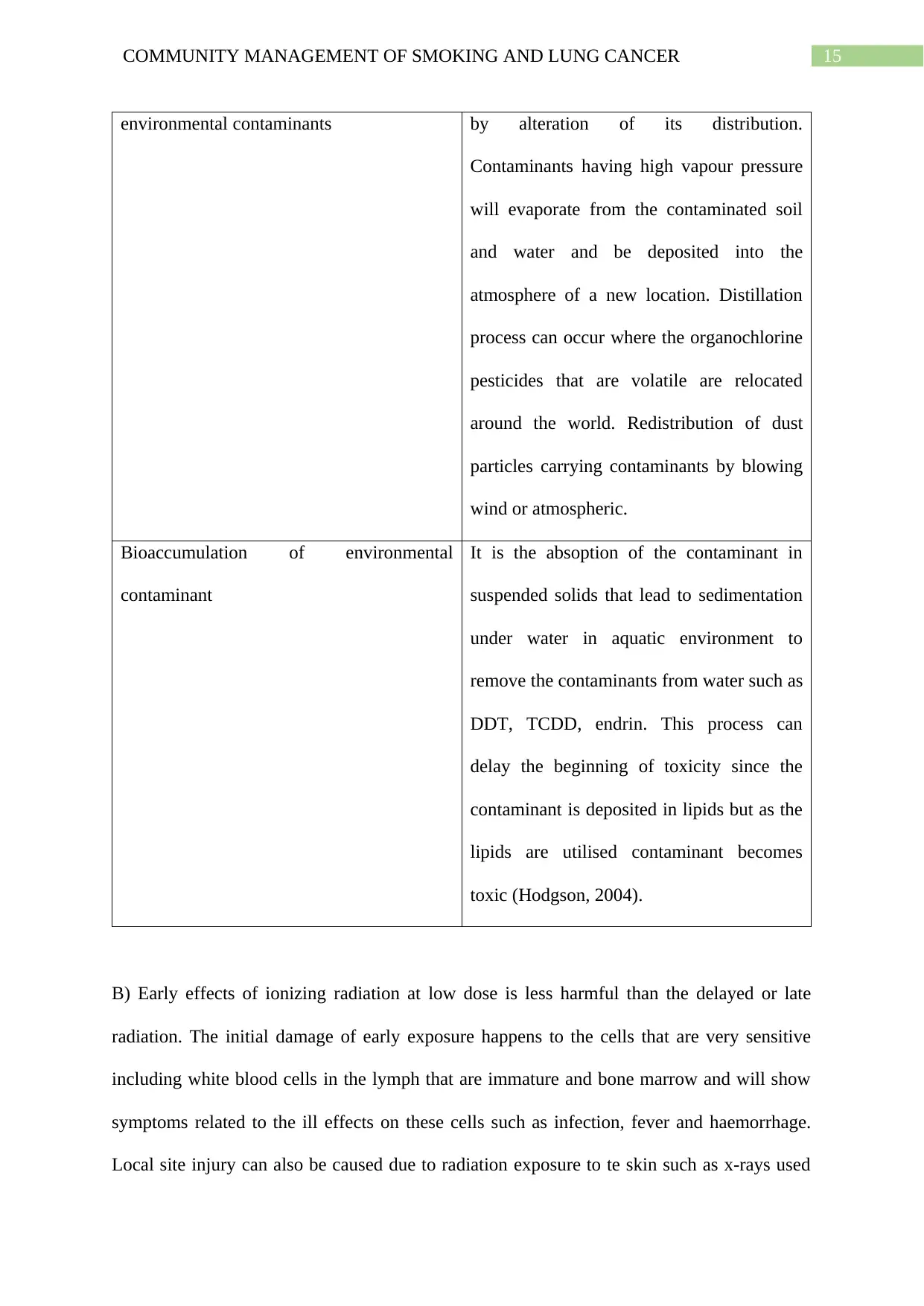
15COMMUNITY MANAGEMENT OF SMOKING AND LUNG CANCER
environmental contaminants by alteration of its distribution.
Contaminants having high vapour pressure
will evaporate from the contaminated soil
and water and be deposited into the
atmosphere of a new location. Distillation
process can occur where the organochlorine
pesticides that are volatile are relocated
around the world. Redistribution of dust
particles carrying contaminants by blowing
wind or atmospheric.
Bioaccumulation of environmental
contaminant
It is the absoption of the contaminant in
suspended solids that lead to sedimentation
under water in aquatic environment to
remove the contaminants from water such as
DDT, TCDD, endrin. This process can
delay the beginning of toxicity since the
contaminant is deposited in lipids but as the
lipids are utilised contaminant becomes
toxic (Hodgson, 2004).
B) Early effects of ionizing radiation at low dose is less harmful than the delayed or late
radiation. The initial damage of early exposure happens to the cells that are very sensitive
including white blood cells in the lymph that are immature and bone marrow and will show
symptoms related to the ill effects on these cells such as infection, fever and haemorrhage.
Local site injury can also be caused due to radiation exposure to te skin such as x-rays used
environmental contaminants by alteration of its distribution.
Contaminants having high vapour pressure
will evaporate from the contaminated soil
and water and be deposited into the
atmosphere of a new location. Distillation
process can occur where the organochlorine
pesticides that are volatile are relocated
around the world. Redistribution of dust
particles carrying contaminants by blowing
wind or atmospheric.
Bioaccumulation of environmental
contaminant
It is the absoption of the contaminant in
suspended solids that lead to sedimentation
under water in aquatic environment to
remove the contaminants from water such as
DDT, TCDD, endrin. This process can
delay the beginning of toxicity since the
contaminant is deposited in lipids but as the
lipids are utilised contaminant becomes
toxic (Hodgson, 2004).
B) Early effects of ionizing radiation at low dose is less harmful than the delayed or late
radiation. The initial damage of early exposure happens to the cells that are very sensitive
including white blood cells in the lymph that are immature and bone marrow and will show
symptoms related to the ill effects on these cells such as infection, fever and haemorrhage.
Local site injury can also be caused due to radiation exposure to te skin such as x-rays used
Secure Best Marks with AI Grader
Need help grading? Try our AI Grader for instant feedback on your assignments.
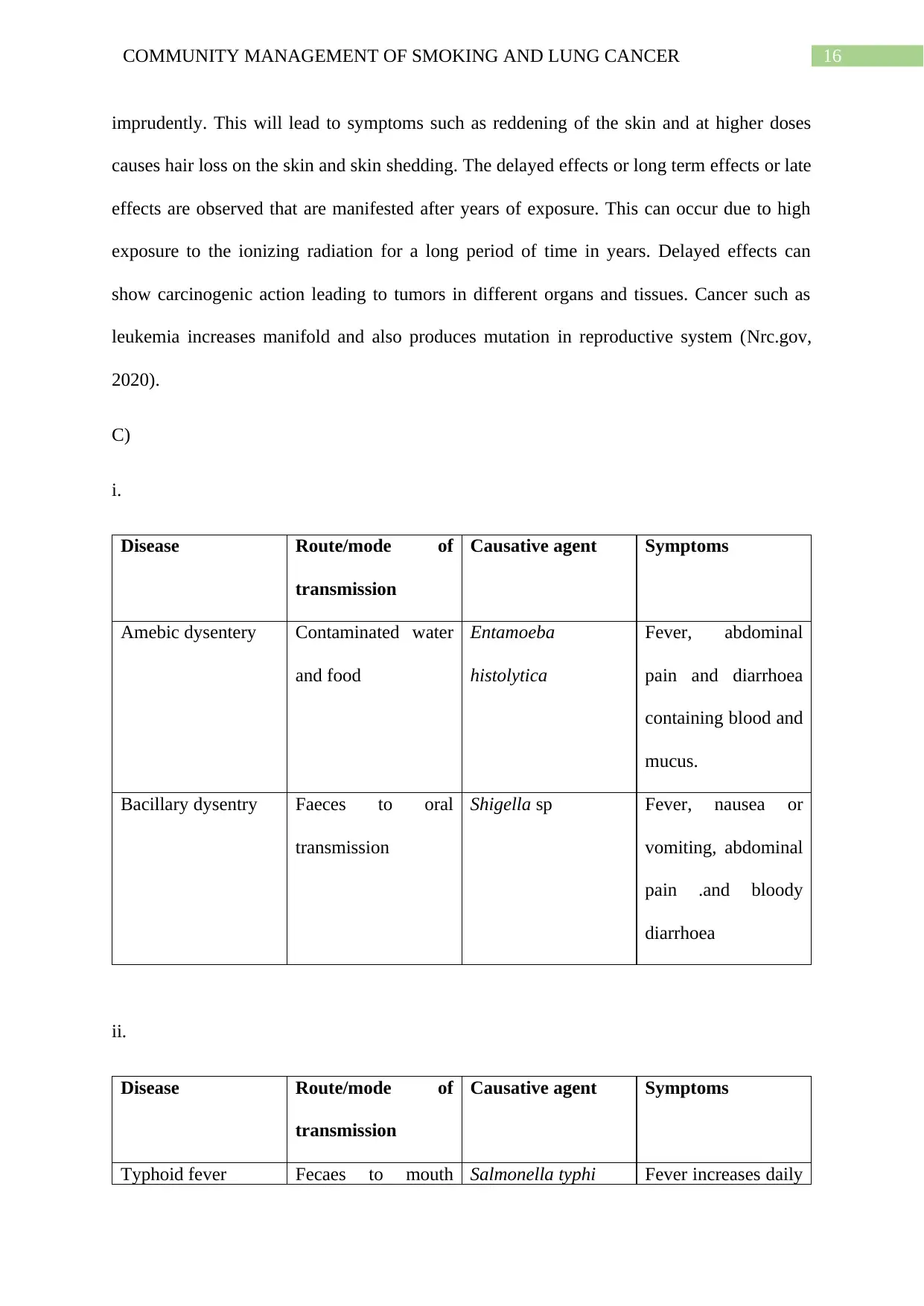
16COMMUNITY MANAGEMENT OF SMOKING AND LUNG CANCER
imprudently. This will lead to symptoms such as reddening of the skin and at higher doses
causes hair loss on the skin and skin shedding. The delayed effects or long term effects or late
effects are observed that are manifested after years of exposure. This can occur due to high
exposure to the ionizing radiation for a long period of time in years. Delayed effects can
show carcinogenic action leading to tumors in different organs and tissues. Cancer such as
leukemia increases manifold and also produces mutation in reproductive system (Nrc.gov,
2020).
C)
i.
Disease Route/mode of
transmission
Causative agent Symptoms
Amebic dysentery Contaminated water
and food
Entamoeba
histolytica
Fever, abdominal
pain and diarrhoea
containing blood and
mucus.
Bacillary dysentry Faeces to oral
transmission
Shigella sp Fever, nausea or
vomiting, abdominal
pain .and bloody
diarrhoea
ii.
Disease Route/mode of
transmission
Causative agent Symptoms
Typhoid fever Fecaes to mouth Salmonella typhi Fever increases daily
imprudently. This will lead to symptoms such as reddening of the skin and at higher doses
causes hair loss on the skin and skin shedding. The delayed effects or long term effects or late
effects are observed that are manifested after years of exposure. This can occur due to high
exposure to the ionizing radiation for a long period of time in years. Delayed effects can
show carcinogenic action leading to tumors in different organs and tissues. Cancer such as
leukemia increases manifold and also produces mutation in reproductive system (Nrc.gov,
2020).
C)
i.
Disease Route/mode of
transmission
Causative agent Symptoms
Amebic dysentery Contaminated water
and food
Entamoeba
histolytica
Fever, abdominal
pain and diarrhoea
containing blood and
mucus.
Bacillary dysentry Faeces to oral
transmission
Shigella sp Fever, nausea or
vomiting, abdominal
pain .and bloody
diarrhoea
ii.
Disease Route/mode of
transmission
Causative agent Symptoms
Typhoid fever Fecaes to mouth Salmonella typhi Fever increases daily

17COMMUNITY MANAGEMENT OF SMOKING AND LUNG CANCER
transmission reaching around
104.9 F, headache
and muscle ache,
fatigue, loss of
apetite and weight,
abdominal pain and
swollen abdomen,
loose motion or
constipation, dry
cough and rashes.
Paratyphoid fever Contaminated food
or water with faeces
Salmonella enterica Fever and headache,
weakness, skin
rashes
iii.
Disease Route/mode of
transmission
Causative agent Symptoms
Campylobacter
enteritis
Foodborne and fecal
oral transmission
Campylobacter
jejuni
Fever and bodyache,
abdominal pain,
bloody diarrhoea.
Gastroenteritis Contaminated food
or unwashed hands
Rotavirus or
Eschericia coli.
Abdominal cramps
and pain, nausea,
fever and headache,
watery diarrhoea and
transmission reaching around
104.9 F, headache
and muscle ache,
fatigue, loss of
apetite and weight,
abdominal pain and
swollen abdomen,
loose motion or
constipation, dry
cough and rashes.
Paratyphoid fever Contaminated food
or water with faeces
Salmonella enterica Fever and headache,
weakness, skin
rashes
iii.
Disease Route/mode of
transmission
Causative agent Symptoms
Campylobacter
enteritis
Foodborne and fecal
oral transmission
Campylobacter
jejuni
Fever and bodyache,
abdominal pain,
bloody diarrhoea.
Gastroenteritis Contaminated food
or unwashed hands
Rotavirus or
Eschericia coli.
Abdominal cramps
and pain, nausea,
fever and headache,
watery diarrhoea and
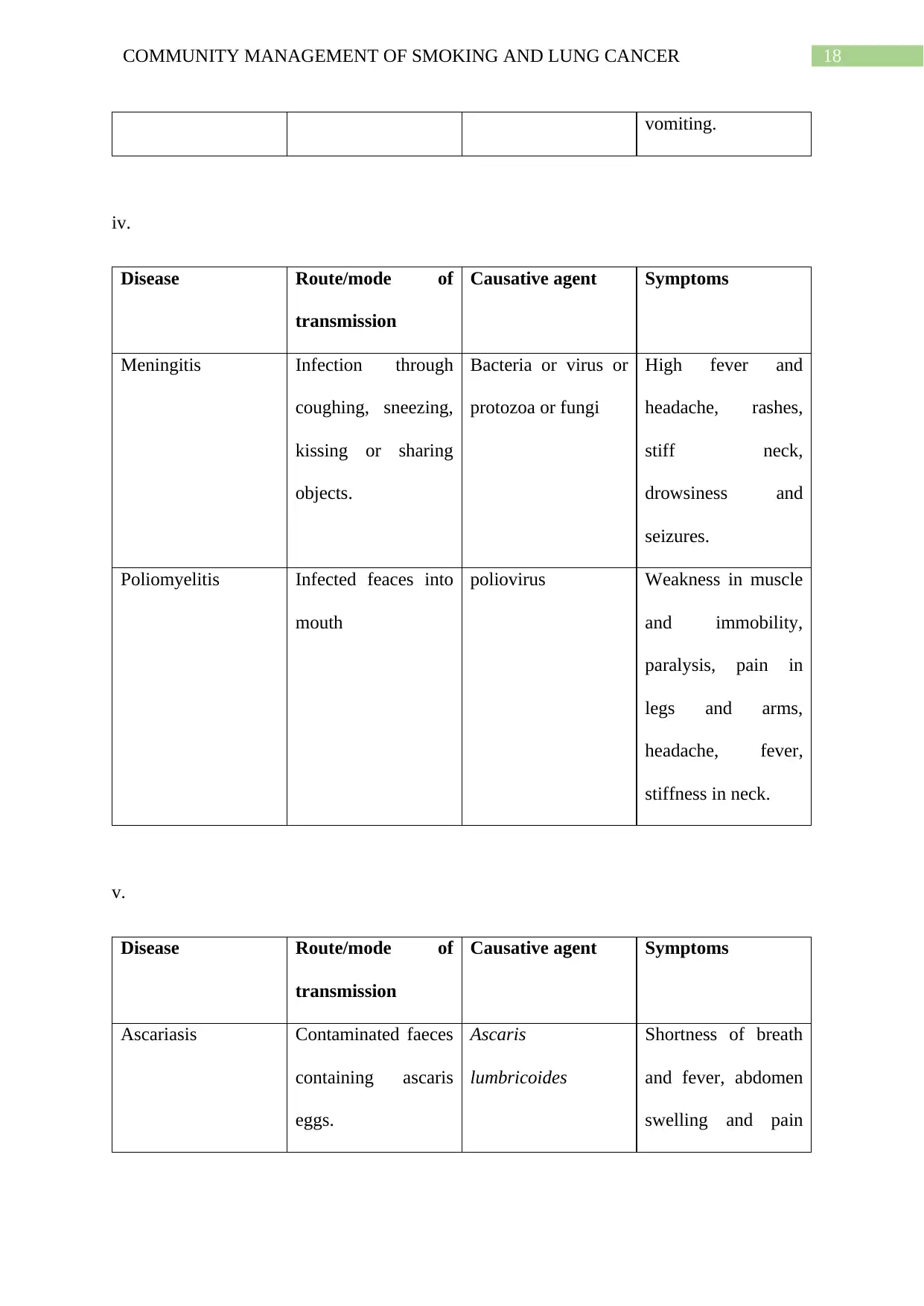
18COMMUNITY MANAGEMENT OF SMOKING AND LUNG CANCER
vomiting.
iv.
Disease Route/mode of
transmission
Causative agent Symptoms
Meningitis Infection through
coughing, sneezing,
kissing or sharing
objects.
Bacteria or virus or
protozoa or fungi
High fever and
headache, rashes,
stiff neck,
drowsiness and
seizures.
Poliomyelitis Infected feaces into
mouth
poliovirus Weakness in muscle
and immobility,
paralysis, pain in
legs and arms,
headache, fever,
stiffness in neck.
v.
Disease Route/mode of
transmission
Causative agent Symptoms
Ascariasis Contaminated faeces
containing ascaris
eggs.
Ascaris
lumbricoides
Shortness of breath
and fever, abdomen
swelling and pain
vomiting.
iv.
Disease Route/mode of
transmission
Causative agent Symptoms
Meningitis Infection through
coughing, sneezing,
kissing or sharing
objects.
Bacteria or virus or
protozoa or fungi
High fever and
headache, rashes,
stiff neck,
drowsiness and
seizures.
Poliomyelitis Infected feaces into
mouth
poliovirus Weakness in muscle
and immobility,
paralysis, pain in
legs and arms,
headache, fever,
stiffness in neck.
v.
Disease Route/mode of
transmission
Causative agent Symptoms
Ascariasis Contaminated faeces
containing ascaris
eggs.
Ascaris
lumbricoides
Shortness of breath
and fever, abdomen
swelling and pain
Paraphrase This Document
Need a fresh take? Get an instant paraphrase of this document with our AI Paraphraser
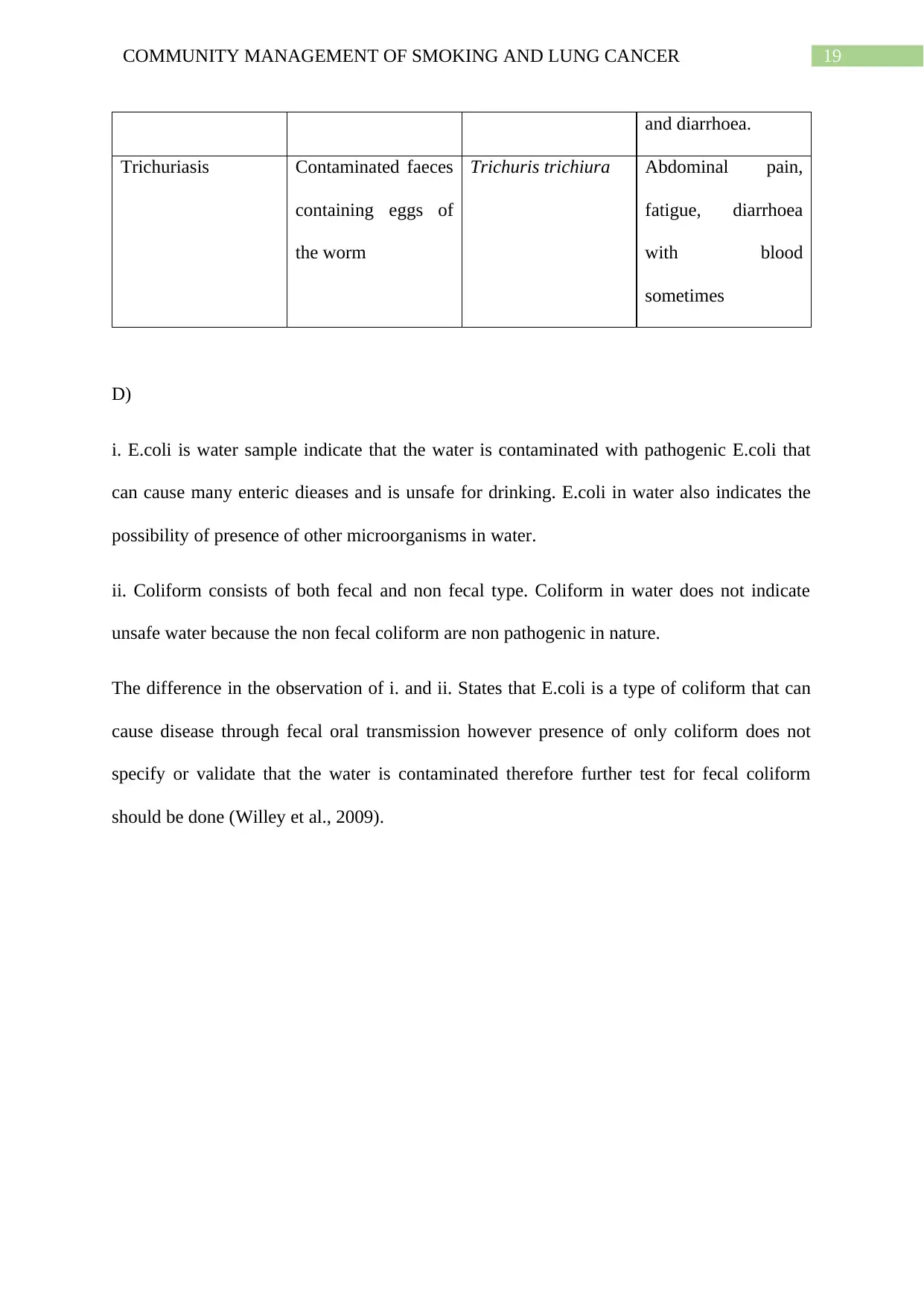
19COMMUNITY MANAGEMENT OF SMOKING AND LUNG CANCER
and diarrhoea.
Trichuriasis Contaminated faeces
containing eggs of
the worm
Trichuris trichiura Abdominal pain,
fatigue, diarrhoea
with blood
sometimes
D)
i. E.coli is water sample indicate that the water is contaminated with pathogenic E.coli that
can cause many enteric dieases and is unsafe for drinking. E.coli in water also indicates the
possibility of presence of other microorganisms in water.
ii. Coliform consists of both fecal and non fecal type. Coliform in water does not indicate
unsafe water because the non fecal coliform are non pathogenic in nature.
The difference in the observation of i. and ii. States that E.coli is a type of coliform that can
cause disease through fecal oral transmission however presence of only coliform does not
specify or validate that the water is contaminated therefore further test for fecal coliform
should be done (Willey et al., 2009).
and diarrhoea.
Trichuriasis Contaminated faeces
containing eggs of
the worm
Trichuris trichiura Abdominal pain,
fatigue, diarrhoea
with blood
sometimes
D)
i. E.coli is water sample indicate that the water is contaminated with pathogenic E.coli that
can cause many enteric dieases and is unsafe for drinking. E.coli in water also indicates the
possibility of presence of other microorganisms in water.
ii. Coliform consists of both fecal and non fecal type. Coliform in water does not indicate
unsafe water because the non fecal coliform are non pathogenic in nature.
The difference in the observation of i. and ii. States that E.coli is a type of coliform that can
cause disease through fecal oral transmission however presence of only coliform does not
specify or validate that the water is contaminated therefore further test for fecal coliform
should be done (Willey et al., 2009).

20COMMUNITY MANAGEMENT OF SMOKING AND LUNG CANCER
References:
Akdis, C. A., & Akdis, M. (2015). Mechanisms of allergen-specific immunotherapy and
immune tolerance to allergens. World Allergy Organization Journal, 8(1), 1-12.
Almazroo, O. A., Miah, M. K., & Venkataramanan, R. (2017). Drug metabolism in the
liver. Clinics in liver disease, 21(1), 1-20.
Alomar M. J. (2014). Factors affecting the development of adverse drug reactions (Review
article). Saudi pharmaceutical journal : SPJ : the official publication of the Saudi
Pharmaceutical Society, 22(2), 83–94. https://doi.org/10.1016/j.jsps.2013.02.003
Amin M. L. (2013). P-glycoprotein Inhibition for Optimal Drug Delivery. Drug target
insights, 7, 27–34. https://doi.org/10.4137/DTI.S12519
Aulbach, A. D., & Amuzie, C. J. (2017). Biomarkers in nonclinical drug development. In A
Comprehensive Guide to Toxicology in Nonclinical Drug Development (pp. 447-471).
Academic Press.
Biondich, A. S., & Joslin, J. D. (2016). Coca: the history and medical significance of an
ancient Andean tradition. Emergency medicine international, 2016.
Chu, R., & Bajaj, P. (2019). Asthma Medication in Children. In StatPearls [Internet].
StatPearls Publishing.
Chung, S. P., & Roh, H. K. (2013). Antidote for organophosphate insecticide poisoning:
atropine and pralidoxime. Journal of the Korean Medical Association/Taehan Uisa
Hyophoe Chi, 56(12).
References:
Akdis, C. A., & Akdis, M. (2015). Mechanisms of allergen-specific immunotherapy and
immune tolerance to allergens. World Allergy Organization Journal, 8(1), 1-12.
Almazroo, O. A., Miah, M. K., & Venkataramanan, R. (2017). Drug metabolism in the
liver. Clinics in liver disease, 21(1), 1-20.
Alomar M. J. (2014). Factors affecting the development of adverse drug reactions (Review
article). Saudi pharmaceutical journal : SPJ : the official publication of the Saudi
Pharmaceutical Society, 22(2), 83–94. https://doi.org/10.1016/j.jsps.2013.02.003
Amin M. L. (2013). P-glycoprotein Inhibition for Optimal Drug Delivery. Drug target
insights, 7, 27–34. https://doi.org/10.4137/DTI.S12519
Aulbach, A. D., & Amuzie, C. J. (2017). Biomarkers in nonclinical drug development. In A
Comprehensive Guide to Toxicology in Nonclinical Drug Development (pp. 447-471).
Academic Press.
Biondich, A. S., & Joslin, J. D. (2016). Coca: the history and medical significance of an
ancient Andean tradition. Emergency medicine international, 2016.
Chu, R., & Bajaj, P. (2019). Asthma Medication in Children. In StatPearls [Internet].
StatPearls Publishing.
Chung, S. P., & Roh, H. K. (2013). Antidote for organophosphate insecticide poisoning:
atropine and pralidoxime. Journal of the Korean Medical Association/Taehan Uisa
Hyophoe Chi, 56(12).
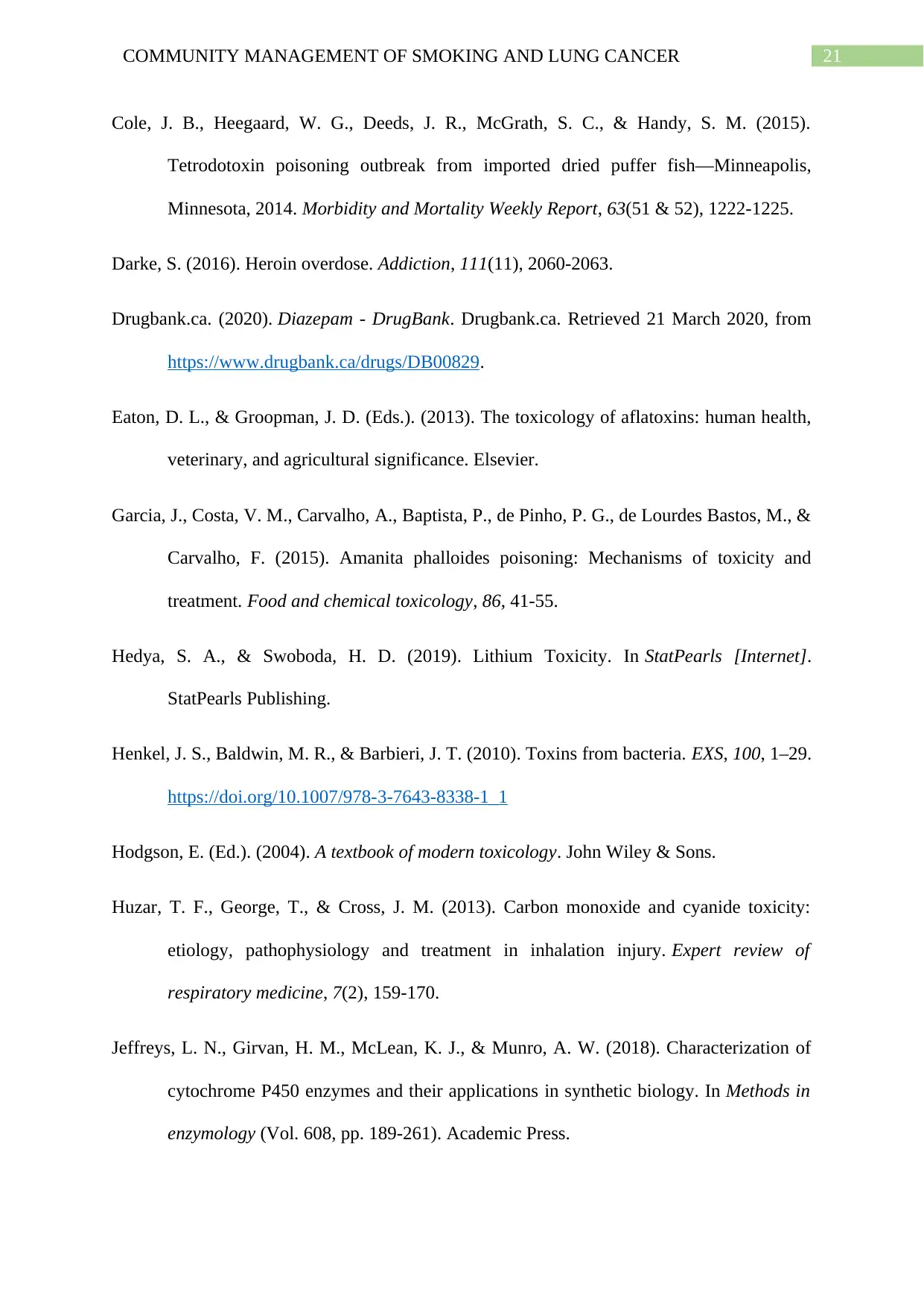
21COMMUNITY MANAGEMENT OF SMOKING AND LUNG CANCER
Cole, J. B., Heegaard, W. G., Deeds, J. R., McGrath, S. C., & Handy, S. M. (2015).
Tetrodotoxin poisoning outbreak from imported dried puffer fish—Minneapolis,
Minnesota, 2014. Morbidity and Mortality Weekly Report, 63(51 & 52), 1222-1225.
Darke, S. (2016). Heroin overdose. Addiction, 111(11), 2060-2063.
Drugbank.ca. (2020). Diazepam - DrugBank. Drugbank.ca. Retrieved 21 March 2020, from
https://www.drugbank.ca/drugs/DB00829.
Eaton, D. L., & Groopman, J. D. (Eds.). (2013). The toxicology of aflatoxins: human health,
veterinary, and agricultural significance. Elsevier.
Garcia, J., Costa, V. M., Carvalho, A., Baptista, P., de Pinho, P. G., de Lourdes Bastos, M., &
Carvalho, F. (2015). Amanita phalloides poisoning: Mechanisms of toxicity and
treatment. Food and chemical toxicology, 86, 41-55.
Hedya, S. A., & Swoboda, H. D. (2019). Lithium Toxicity. In StatPearls [Internet].
StatPearls Publishing.
Henkel, J. S., Baldwin, M. R., & Barbieri, J. T. (2010). Toxins from bacteria. EXS, 100, 1–29.
https://doi.org/10.1007/978-3-7643-8338-1_1
Hodgson, E. (Ed.). (2004). A textbook of modern toxicology. John Wiley & Sons.
Huzar, T. F., George, T., & Cross, J. M. (2013). Carbon monoxide and cyanide toxicity:
etiology, pathophysiology and treatment in inhalation injury. Expert review of
respiratory medicine, 7(2), 159-170.
Jeffreys, L. N., Girvan, H. M., McLean, K. J., & Munro, A. W. (2018). Characterization of
cytochrome P450 enzymes and their applications in synthetic biology. In Methods in
enzymology (Vol. 608, pp. 189-261). Academic Press.
Cole, J. B., Heegaard, W. G., Deeds, J. R., McGrath, S. C., & Handy, S. M. (2015).
Tetrodotoxin poisoning outbreak from imported dried puffer fish—Minneapolis,
Minnesota, 2014. Morbidity and Mortality Weekly Report, 63(51 & 52), 1222-1225.
Darke, S. (2016). Heroin overdose. Addiction, 111(11), 2060-2063.
Drugbank.ca. (2020). Diazepam - DrugBank. Drugbank.ca. Retrieved 21 March 2020, from
https://www.drugbank.ca/drugs/DB00829.
Eaton, D. L., & Groopman, J. D. (Eds.). (2013). The toxicology of aflatoxins: human health,
veterinary, and agricultural significance. Elsevier.
Garcia, J., Costa, V. M., Carvalho, A., Baptista, P., de Pinho, P. G., de Lourdes Bastos, M., &
Carvalho, F. (2015). Amanita phalloides poisoning: Mechanisms of toxicity and
treatment. Food and chemical toxicology, 86, 41-55.
Hedya, S. A., & Swoboda, H. D. (2019). Lithium Toxicity. In StatPearls [Internet].
StatPearls Publishing.
Henkel, J. S., Baldwin, M. R., & Barbieri, J. T. (2010). Toxins from bacteria. EXS, 100, 1–29.
https://doi.org/10.1007/978-3-7643-8338-1_1
Hodgson, E. (Ed.). (2004). A textbook of modern toxicology. John Wiley & Sons.
Huzar, T. F., George, T., & Cross, J. M. (2013). Carbon monoxide and cyanide toxicity:
etiology, pathophysiology and treatment in inhalation injury. Expert review of
respiratory medicine, 7(2), 159-170.
Jeffreys, L. N., Girvan, H. M., McLean, K. J., & Munro, A. W. (2018). Characterization of
cytochrome P450 enzymes and their applications in synthetic biology. In Methods in
enzymology (Vol. 608, pp. 189-261). Academic Press.
Secure Best Marks with AI Grader
Need help grading? Try our AI Grader for instant feedback on your assignments.

22COMMUNITY MANAGEMENT OF SMOKING AND LUNG CANCER
Karamanlioglu, M., Preziosi, R., & Robson, G. D. (2017). Abiotic and biotic environmental
degradation of the bioplastic polymer poly (lactic acid): a review. Polymer
Degradation and stability, 137, 122-130.
Lewis, C. B., & Adams, N. (2019). Phenobarbital. In StatPearls [Internet]. StatPearls
Publishing.
Manikandan, P., & Nagini, S. (2018). Cytochrome P450 structure, function and clinical
significance: a review. Current drug targets, 19(1), 38-54.
nhs.uk. 2020. "Poisoning - Treatment". Nhs.Uk.
https://www.nhs.uk/conditions/poisoning/treatment/.
Nrc.gov. 2020. "Biological Effects Of Radiation". Nrc.Gov. https://www.nrc.gov/reading-
rm/basic-ref/students/for-educators/09.pdf.
Rai, N., Banerjee, D., & Bhattacharyya, R. (2014). Urinary melamine: proposed parameter of
melamine adulteration of food. Nutrition, 30(4), 380-385.
Robertson, A., Garcia, A. C., Quintana, H. A. F., Smith, T. B., II, B. F. C., Reale-Munroe, K.,
... & Klimek, B. J. (2014). Invasive lionfish (Pterois volitans): a potential human
health threat for ciguatera fish poisoning in tropical waters. Marine drugs, 12(1), 88-
97.
Rowdhwal, S. S. S., & Chen, J. (2018). Toxic effects of di-2-ethylhexyl phthalate: an
overview. BioMed research international, 2018.
Silberman, J., & Taylor, A. (2020). Carbamate toxicity. In StatPearls [Internet]. StatPearls
Publishing.
Stanley, L. A. (2017). Drug metabolism. In Pharmacognosy (pp. 527-545). Academic Press.
Karamanlioglu, M., Preziosi, R., & Robson, G. D. (2017). Abiotic and biotic environmental
degradation of the bioplastic polymer poly (lactic acid): a review. Polymer
Degradation and stability, 137, 122-130.
Lewis, C. B., & Adams, N. (2019). Phenobarbital. In StatPearls [Internet]. StatPearls
Publishing.
Manikandan, P., & Nagini, S. (2018). Cytochrome P450 structure, function and clinical
significance: a review. Current drug targets, 19(1), 38-54.
nhs.uk. 2020. "Poisoning - Treatment". Nhs.Uk.
https://www.nhs.uk/conditions/poisoning/treatment/.
Nrc.gov. 2020. "Biological Effects Of Radiation". Nrc.Gov. https://www.nrc.gov/reading-
rm/basic-ref/students/for-educators/09.pdf.
Rai, N., Banerjee, D., & Bhattacharyya, R. (2014). Urinary melamine: proposed parameter of
melamine adulteration of food. Nutrition, 30(4), 380-385.
Robertson, A., Garcia, A. C., Quintana, H. A. F., Smith, T. B., II, B. F. C., Reale-Munroe, K.,
... & Klimek, B. J. (2014). Invasive lionfish (Pterois volitans): a potential human
health threat for ciguatera fish poisoning in tropical waters. Marine drugs, 12(1), 88-
97.
Rowdhwal, S. S. S., & Chen, J. (2018). Toxic effects of di-2-ethylhexyl phthalate: an
overview. BioMed research international, 2018.
Silberman, J., & Taylor, A. (2020). Carbamate toxicity. In StatPearls [Internet]. StatPearls
Publishing.
Stanley, L. A. (2017). Drug metabolism. In Pharmacognosy (pp. 527-545). Academic Press.

23COMMUNITY MANAGEMENT OF SMOKING AND LUNG CANCER
Susarla, S. M., Mulliken, J. B., Kaban, L. B., Manson, P. N., & Dodson, T. B. (2017). The
colourful history of malachite green: from ancient Egypt to modern
surgery. International journal of oral and maxillofacial surgery, 46(3), 401-403.
Susilowati, R. W., Prayuni, K., Razari, I., Bahri, S., & Yuliwulandari, R. (2017). High
frequency of NAT2 slow acetylator alleles in the Malay population of Indonesia: an
awareness to the anti-tuberculosis drug induced liver injury and cancer. Medical
Journal of Indonesia, 26(1), 7-13
Taxak, N., & Bharatam, P. V. (2014). Drug metabolism. Resonance, 19(3), 259-282.
Teng, Y., & Zhou, Q. (2017). Environmental effect of Sudan I-IV: adsorption behaviors and
potential risk on soil. Acta Scientifica Malaysia (ASM), 1(1), 14-15.
Wertheim, H. F., Horby, P., & Woodall, J. P. (Eds.). (2012). Atlas of human infectious
diseases. John Wiley & Sons.
Who.int. (2020). Retrieved 21 March 2020, from
https://www.who.int/tdr/publications/documents/malaria-diagnosis.pdf.
Willey, J. M., Sherwood, L., & Woolverton, C. J. (2009). Prescott's principles of
microbiology. Boston (MA): McGraw-Hill Higher Education.
Wong, J. H. (2013). Fungal Toxins. In Handbook of Biologically Active Peptides (pp. 166-
168). Academic Press.
Susarla, S. M., Mulliken, J. B., Kaban, L. B., Manson, P. N., & Dodson, T. B. (2017). The
colourful history of malachite green: from ancient Egypt to modern
surgery. International journal of oral and maxillofacial surgery, 46(3), 401-403.
Susilowati, R. W., Prayuni, K., Razari, I., Bahri, S., & Yuliwulandari, R. (2017). High
frequency of NAT2 slow acetylator alleles in the Malay population of Indonesia: an
awareness to the anti-tuberculosis drug induced liver injury and cancer. Medical
Journal of Indonesia, 26(1), 7-13
Taxak, N., & Bharatam, P. V. (2014). Drug metabolism. Resonance, 19(3), 259-282.
Teng, Y., & Zhou, Q. (2017). Environmental effect of Sudan I-IV: adsorption behaviors and
potential risk on soil. Acta Scientifica Malaysia (ASM), 1(1), 14-15.
Wertheim, H. F., Horby, P., & Woodall, J. P. (Eds.). (2012). Atlas of human infectious
diseases. John Wiley & Sons.
Who.int. (2020). Retrieved 21 March 2020, from
https://www.who.int/tdr/publications/documents/malaria-diagnosis.pdf.
Willey, J. M., Sherwood, L., & Woolverton, C. J. (2009). Prescott's principles of
microbiology. Boston (MA): McGraw-Hill Higher Education.
Wong, J. H. (2013). Fungal Toxins. In Handbook of Biologically Active Peptides (pp. 166-
168). Academic Press.
1 out of 24
Your All-in-One AI-Powered Toolkit for Academic Success.
+13062052269
info@desklib.com
Available 24*7 on WhatsApp / Email
![[object Object]](/_next/static/media/star-bottom.7253800d.svg)
Unlock your academic potential
© 2024 | Zucol Services PVT LTD | All rights reserved.